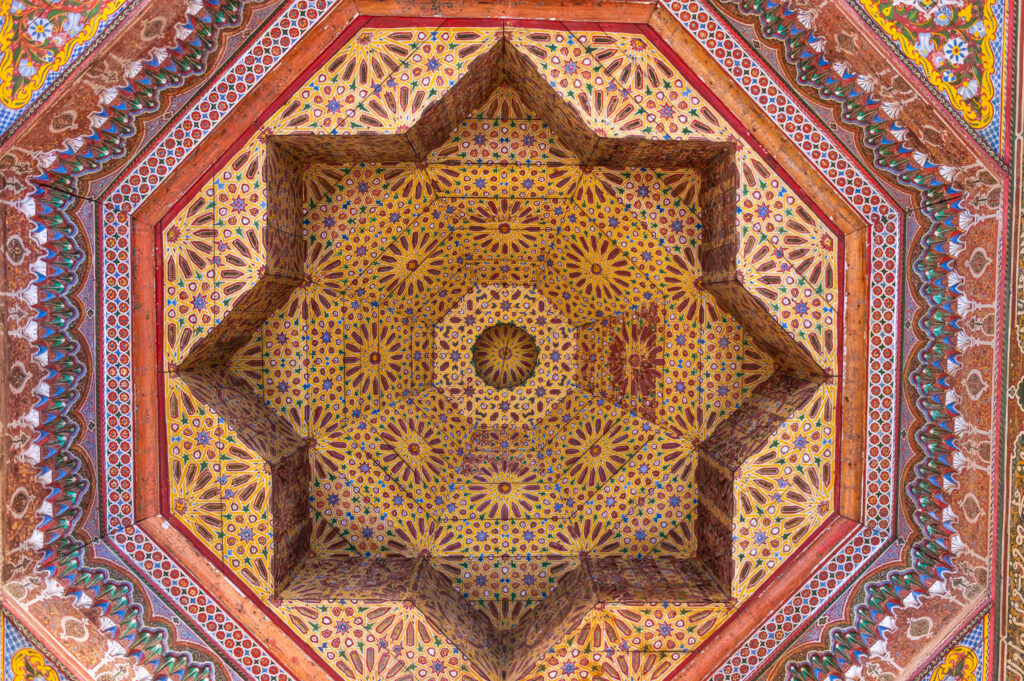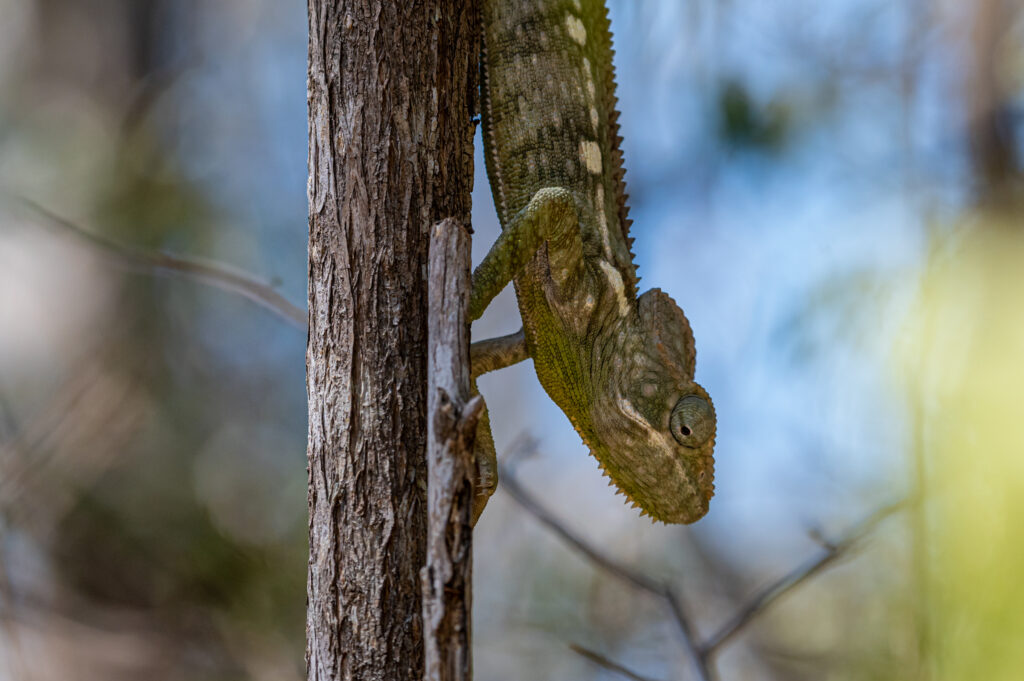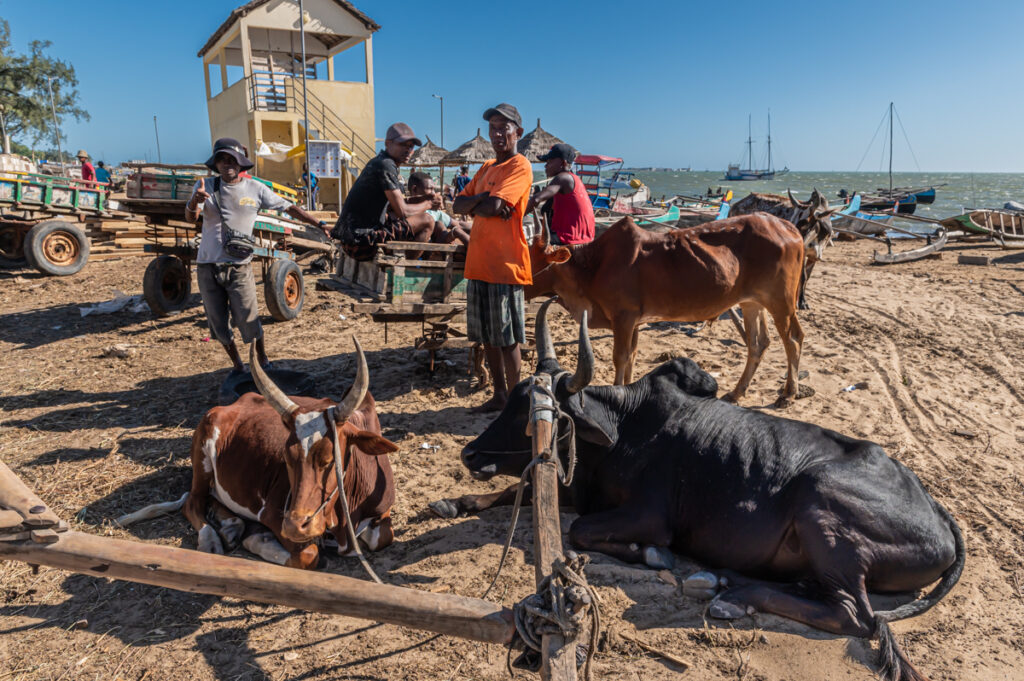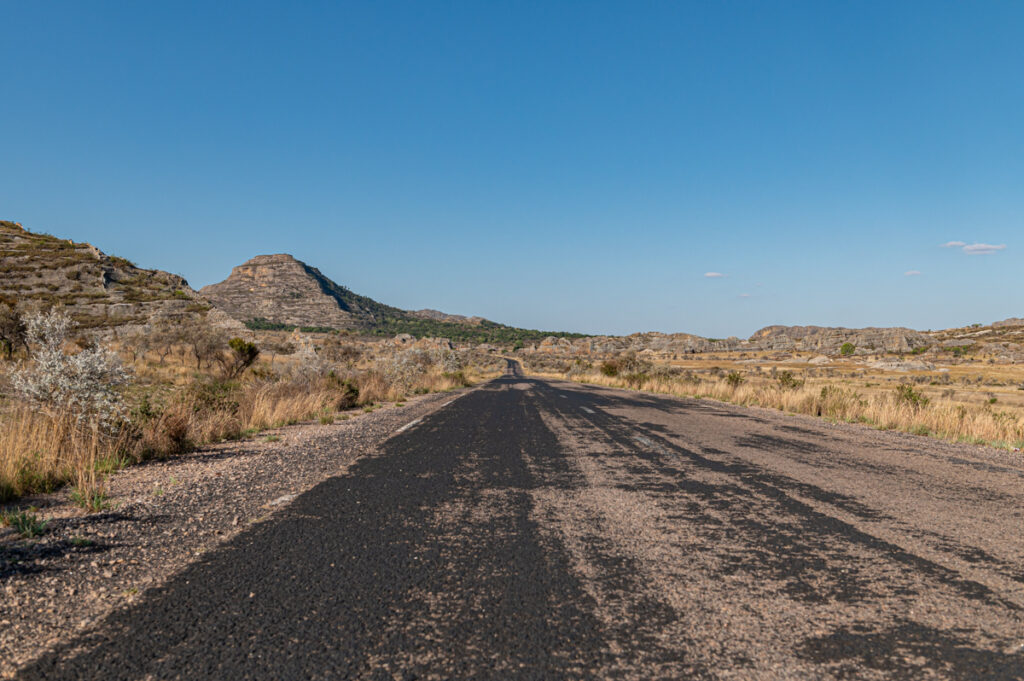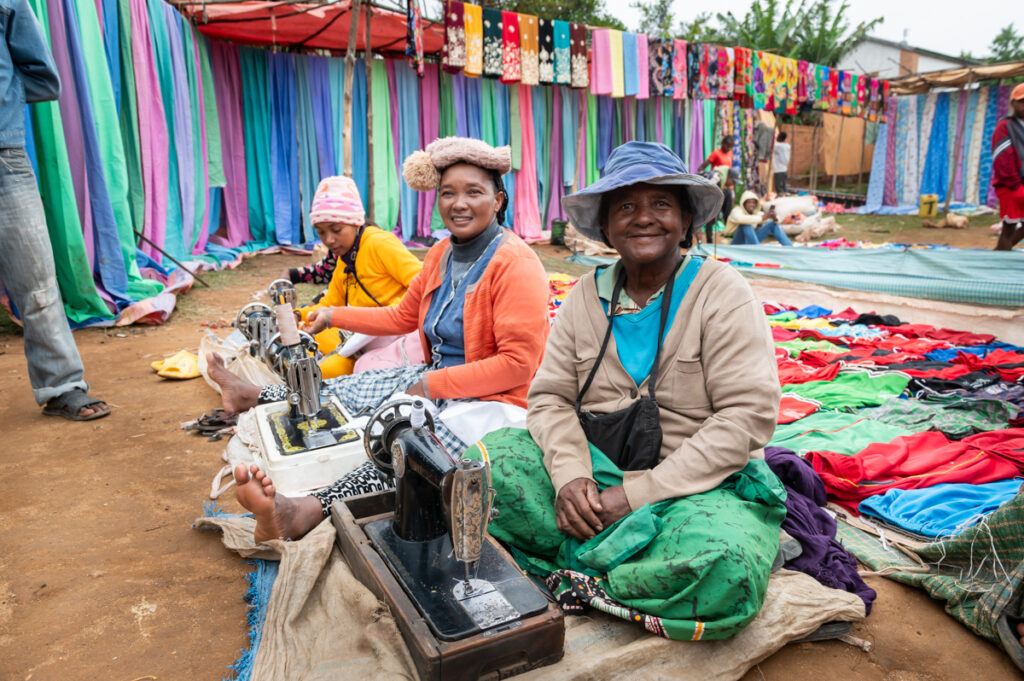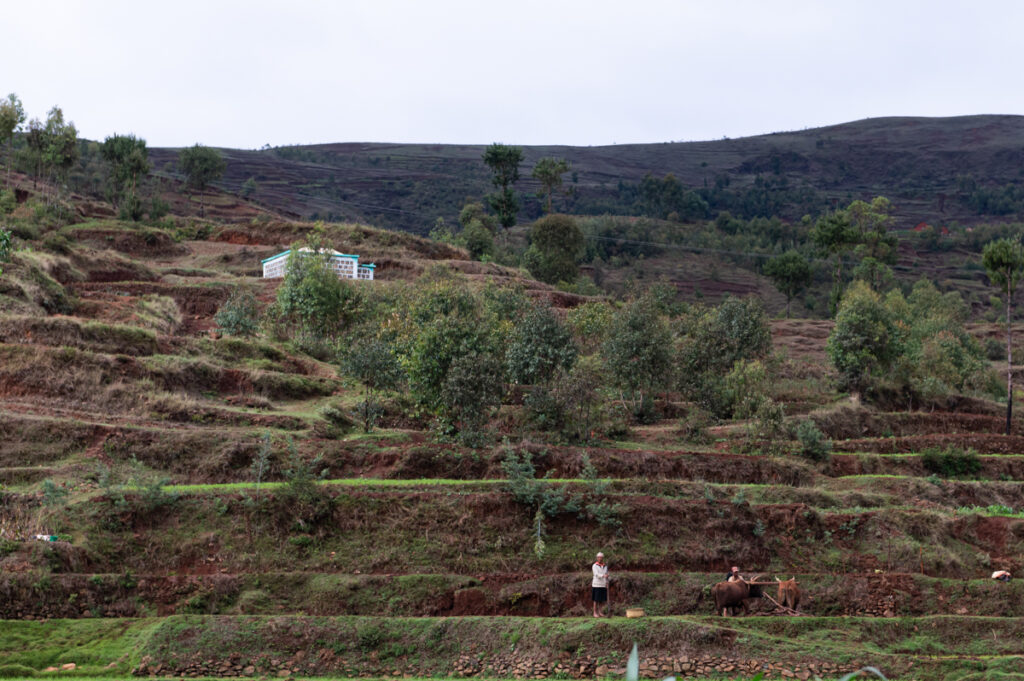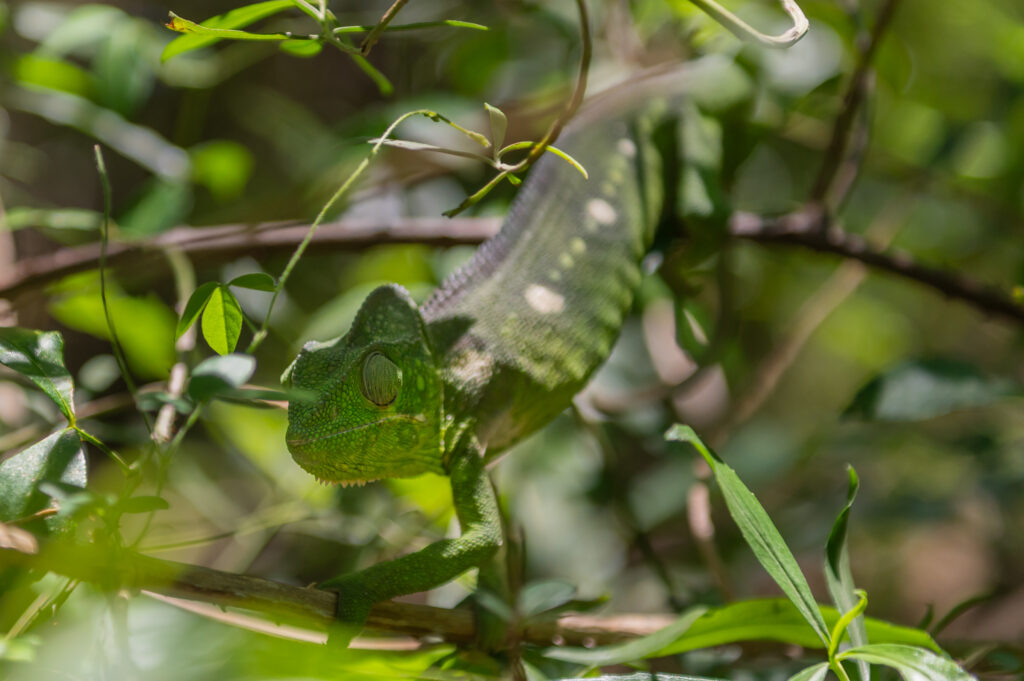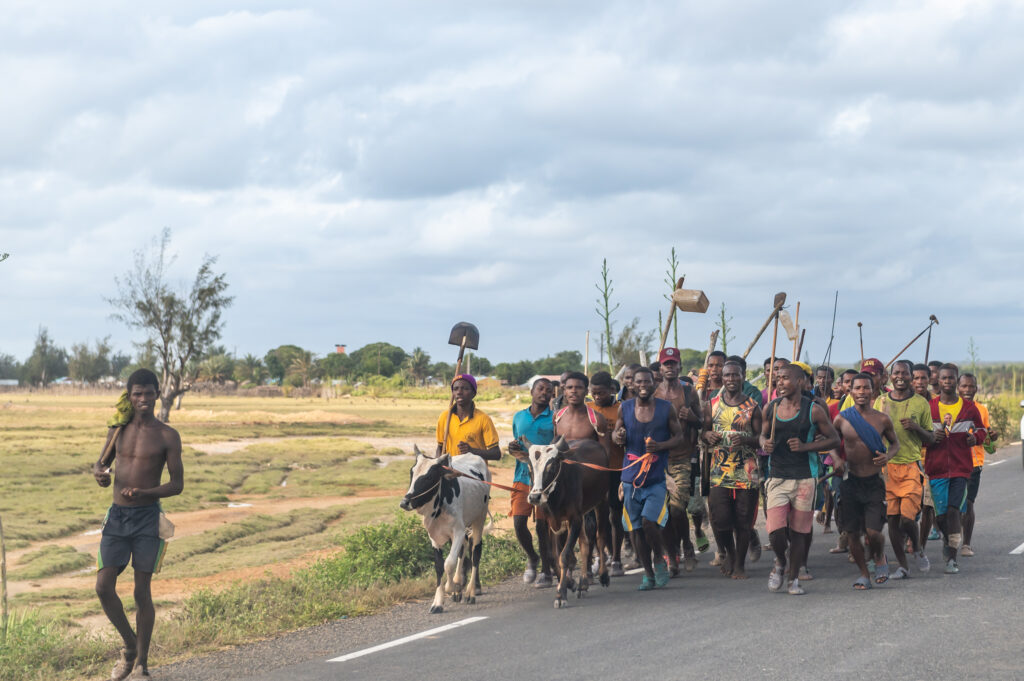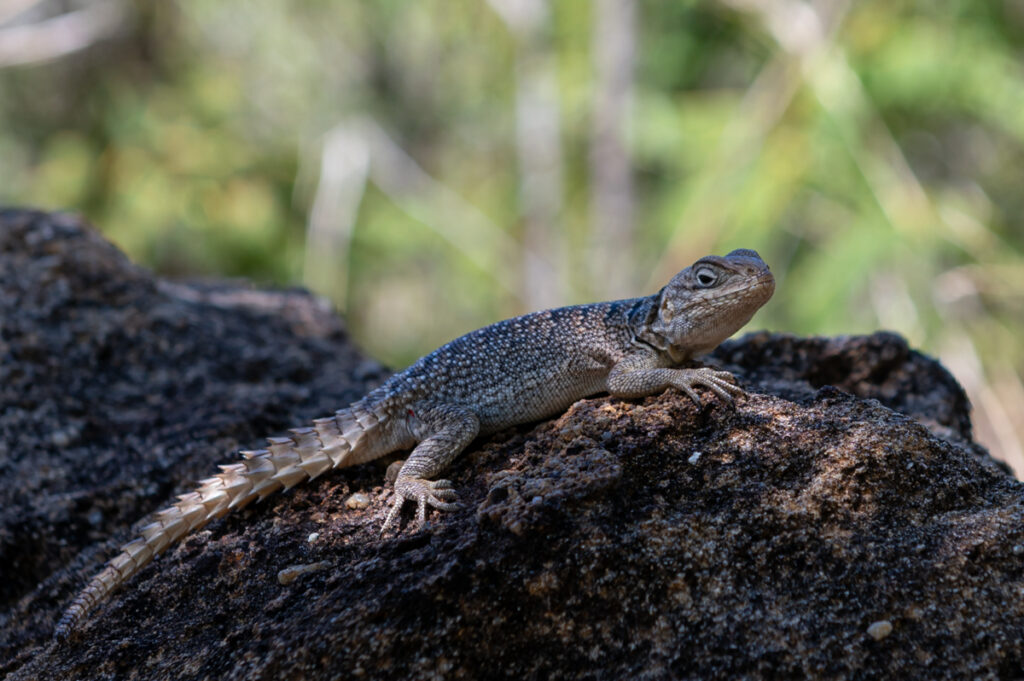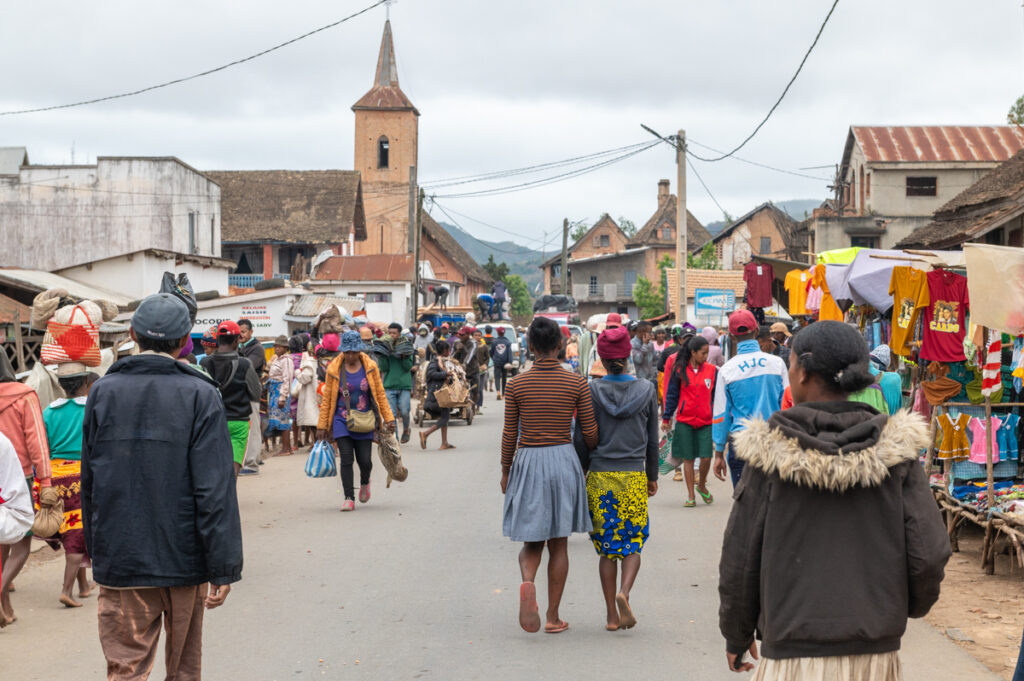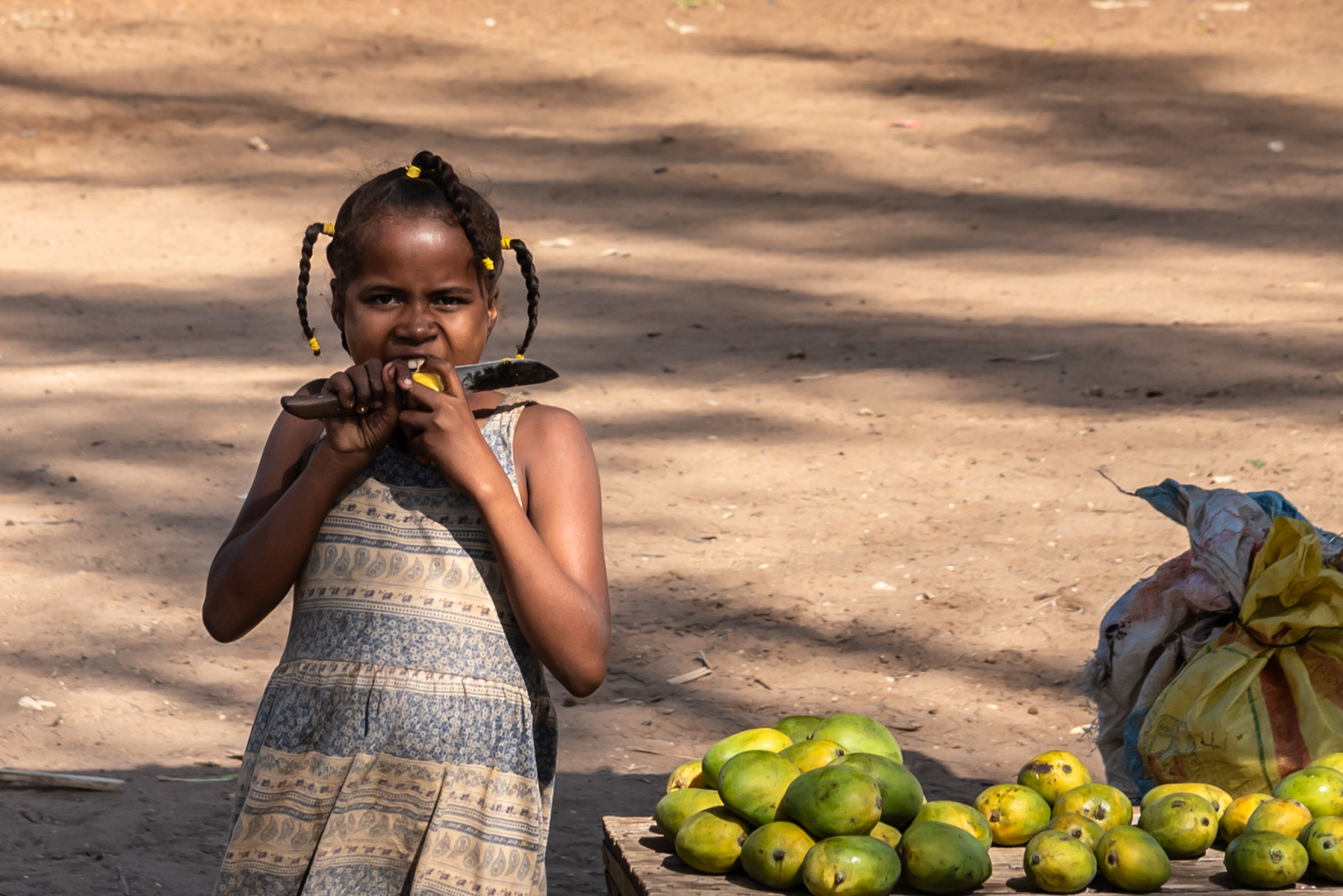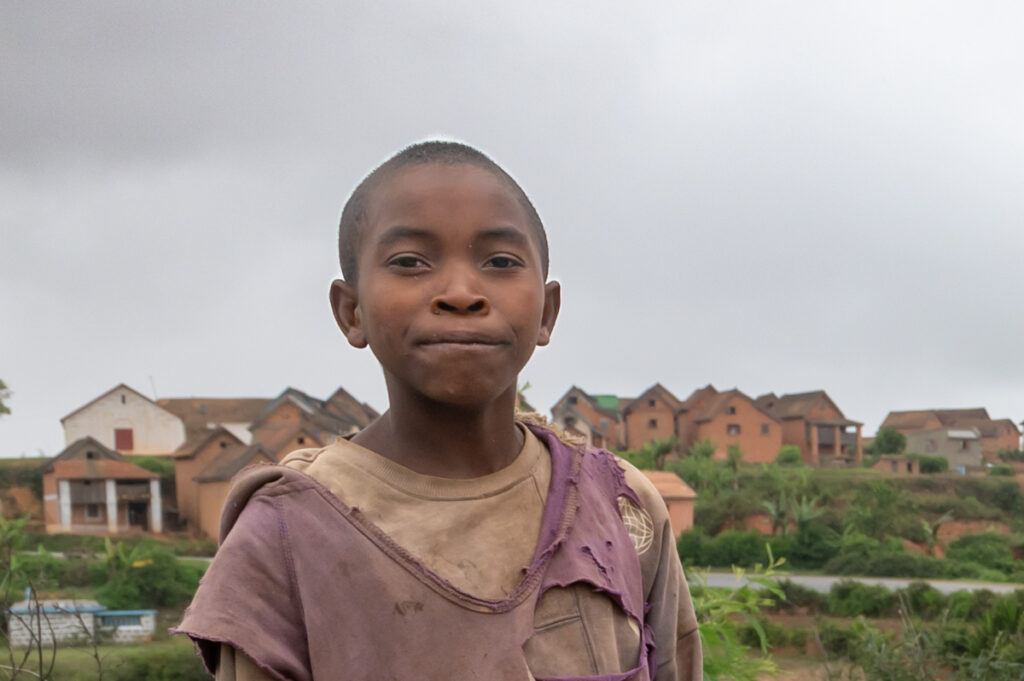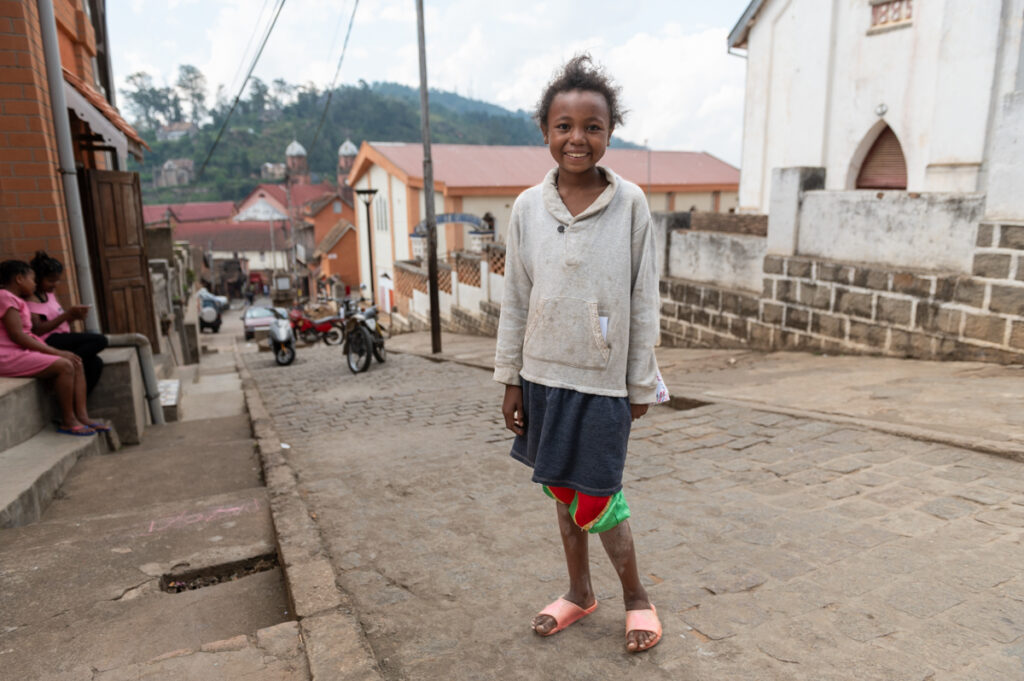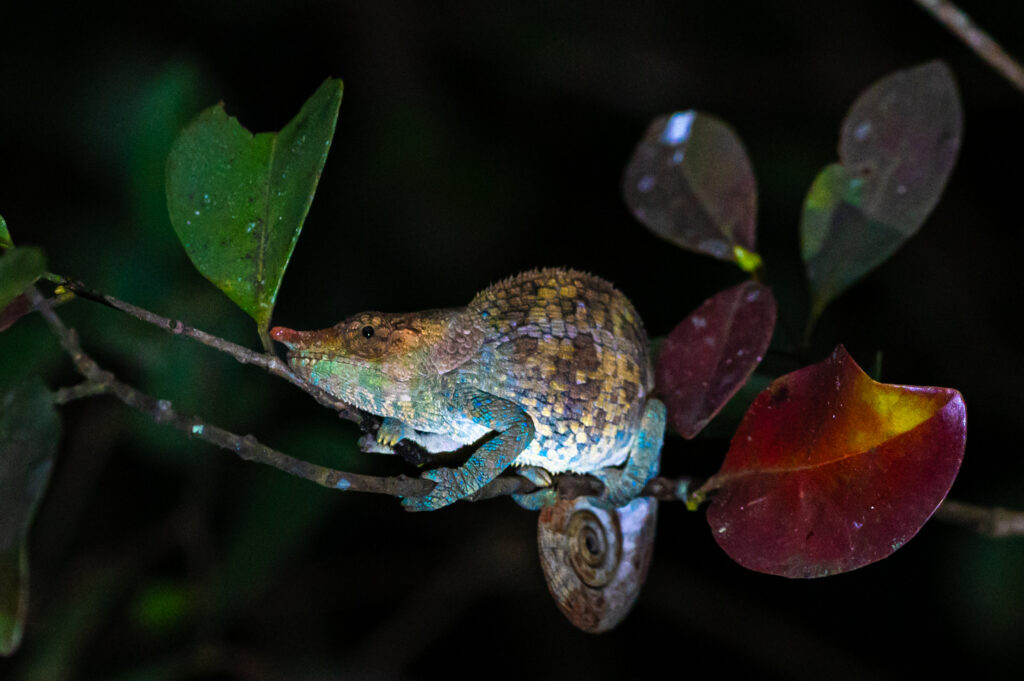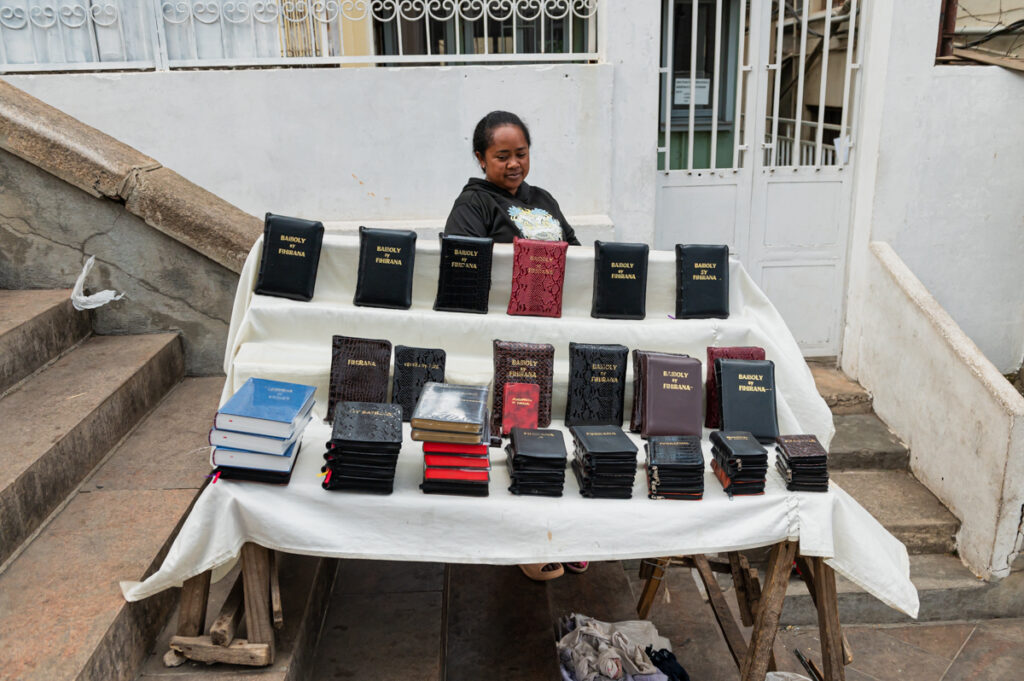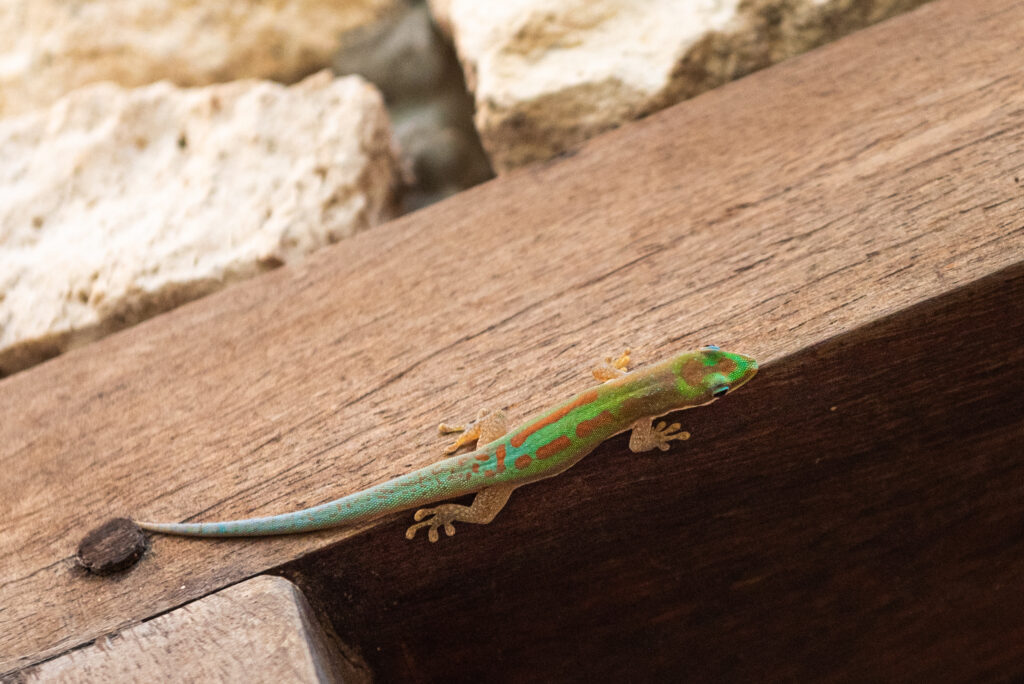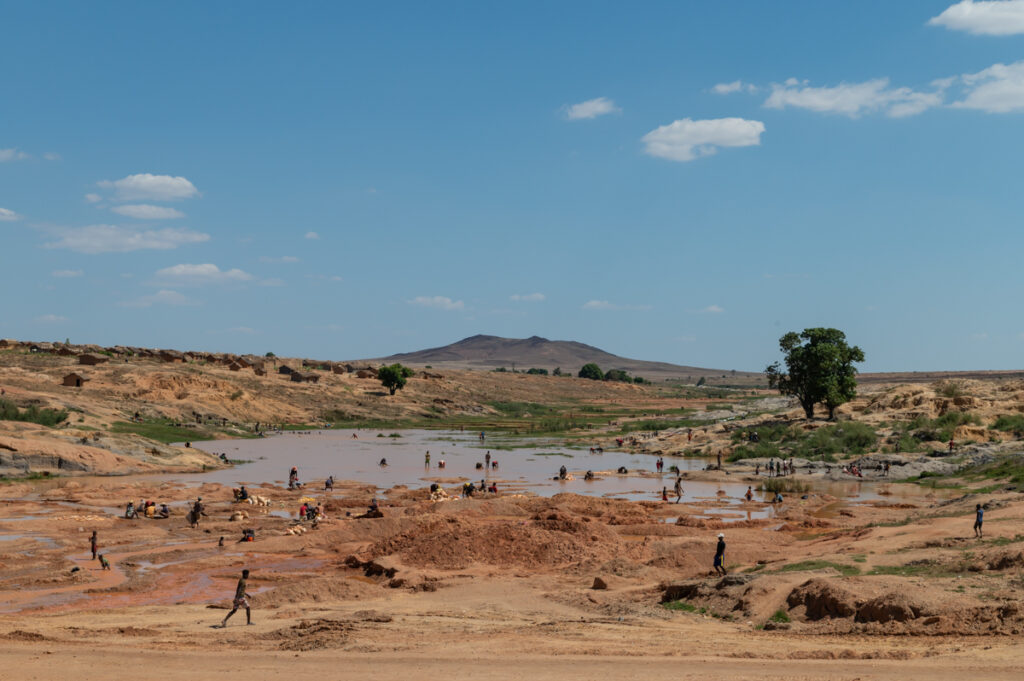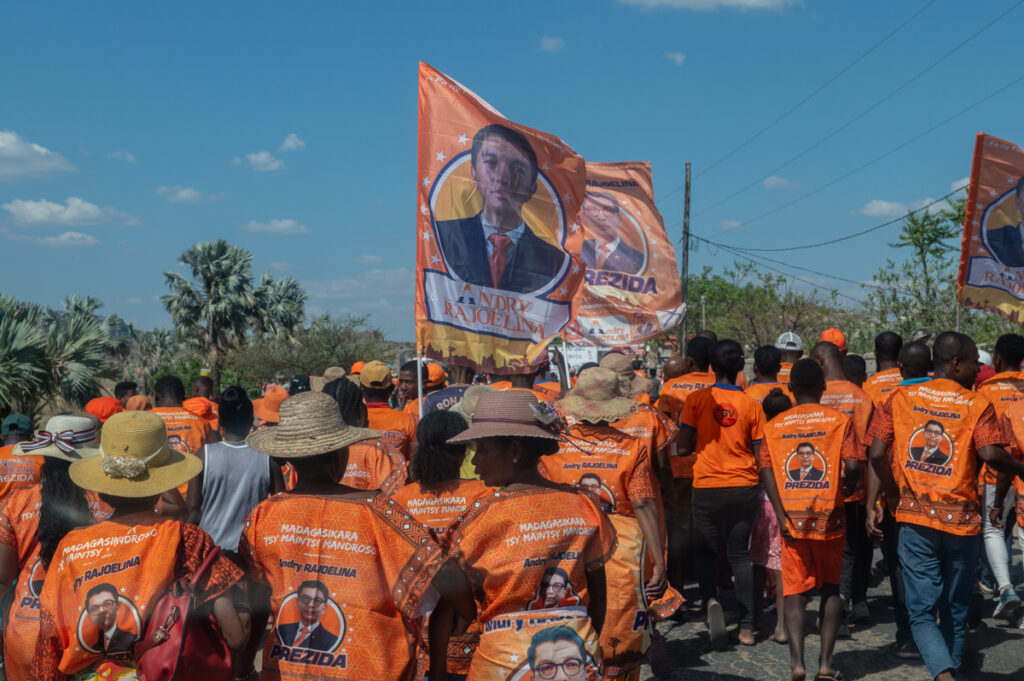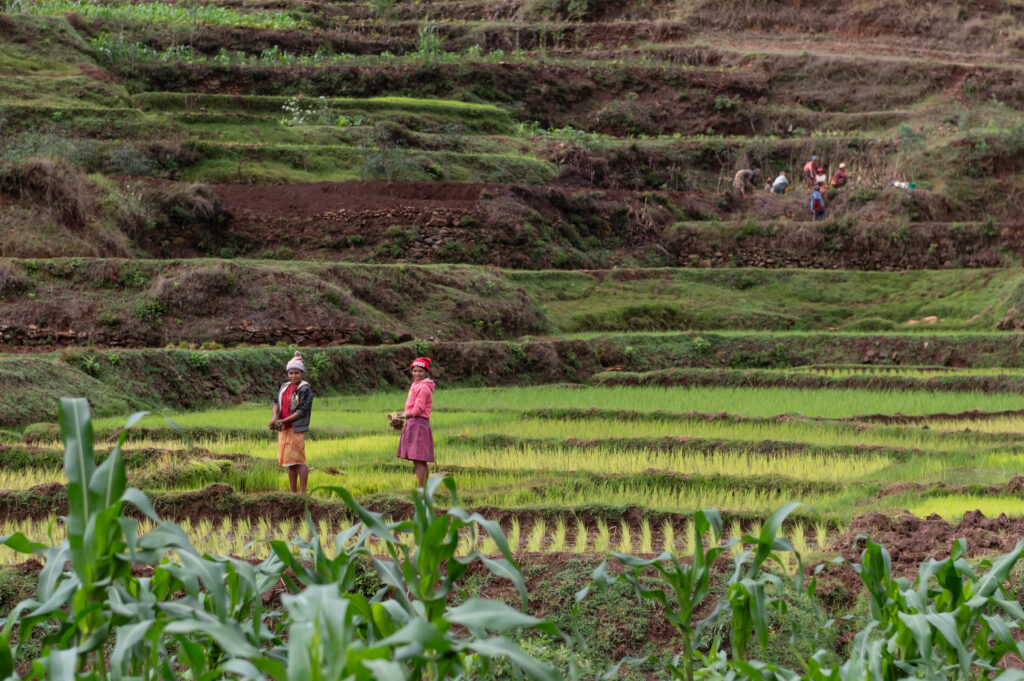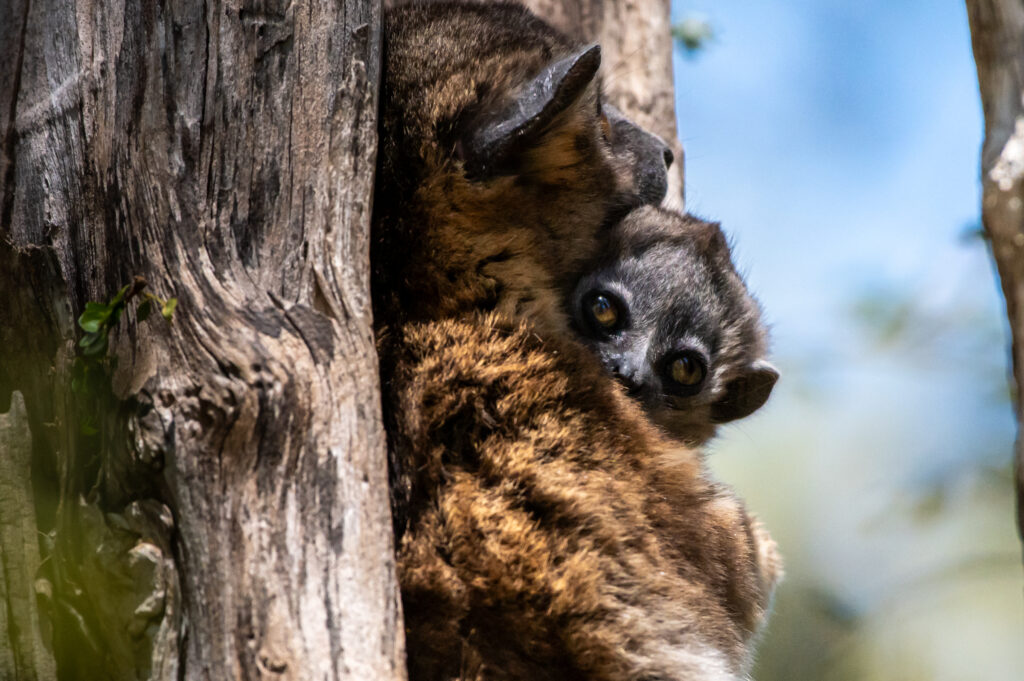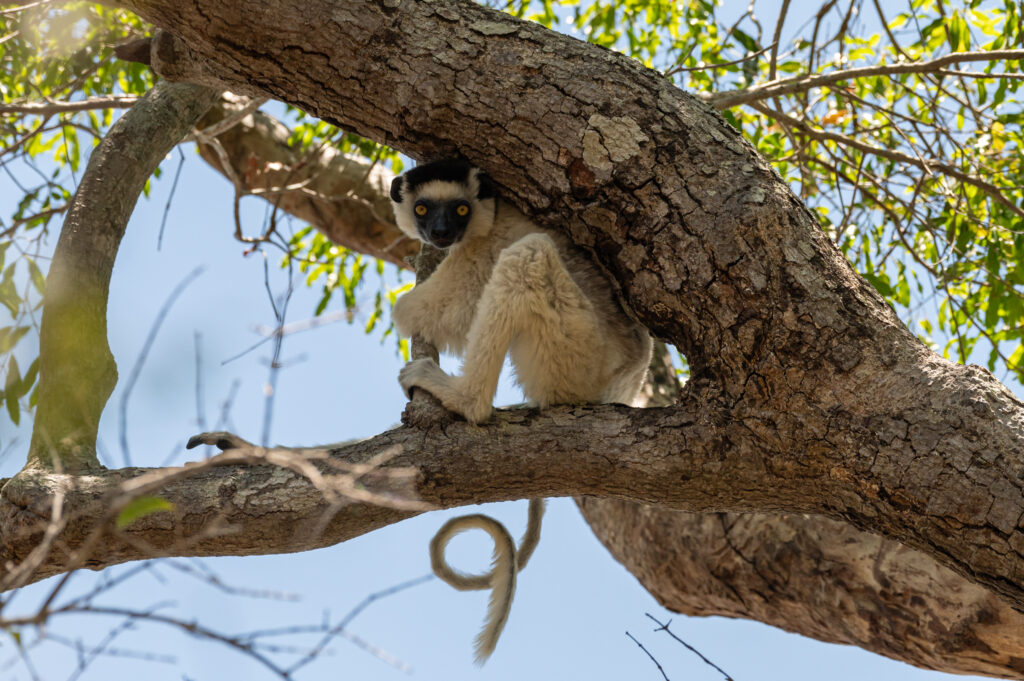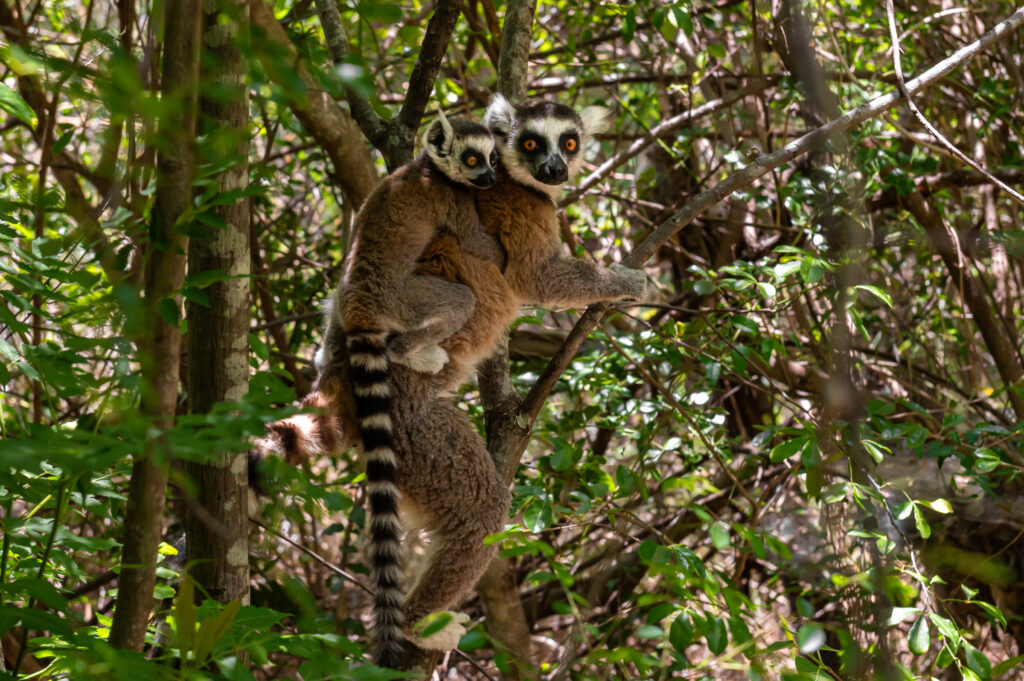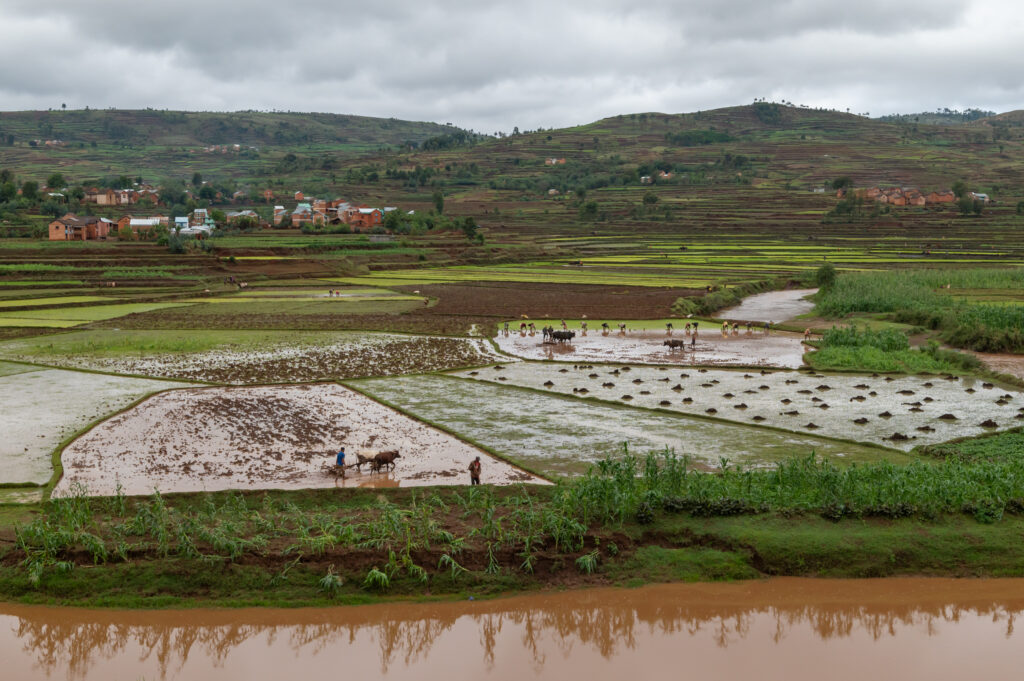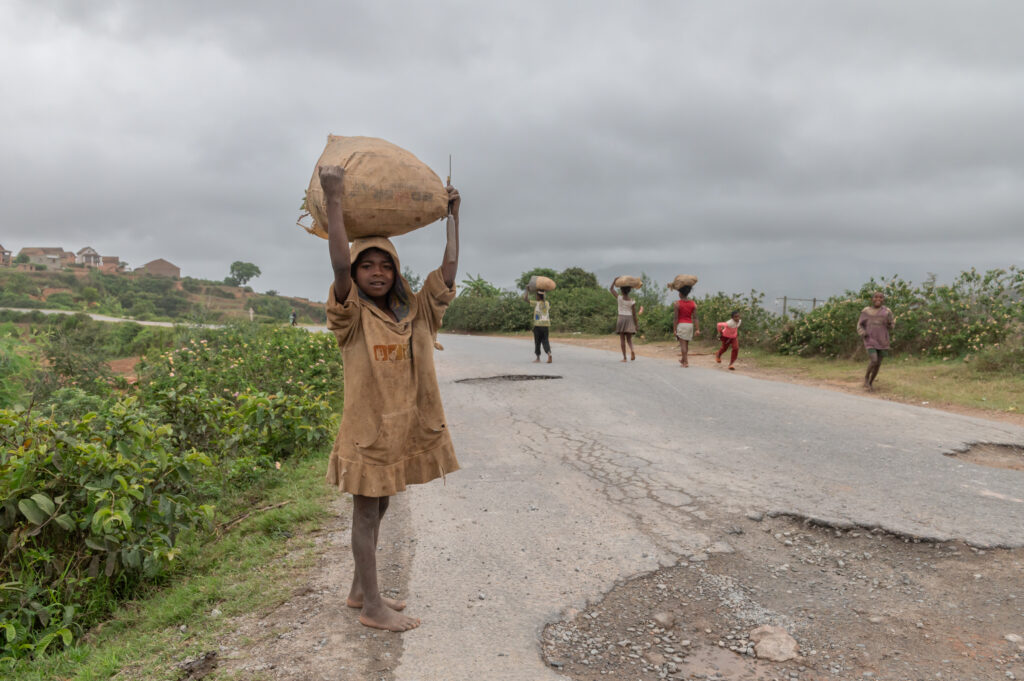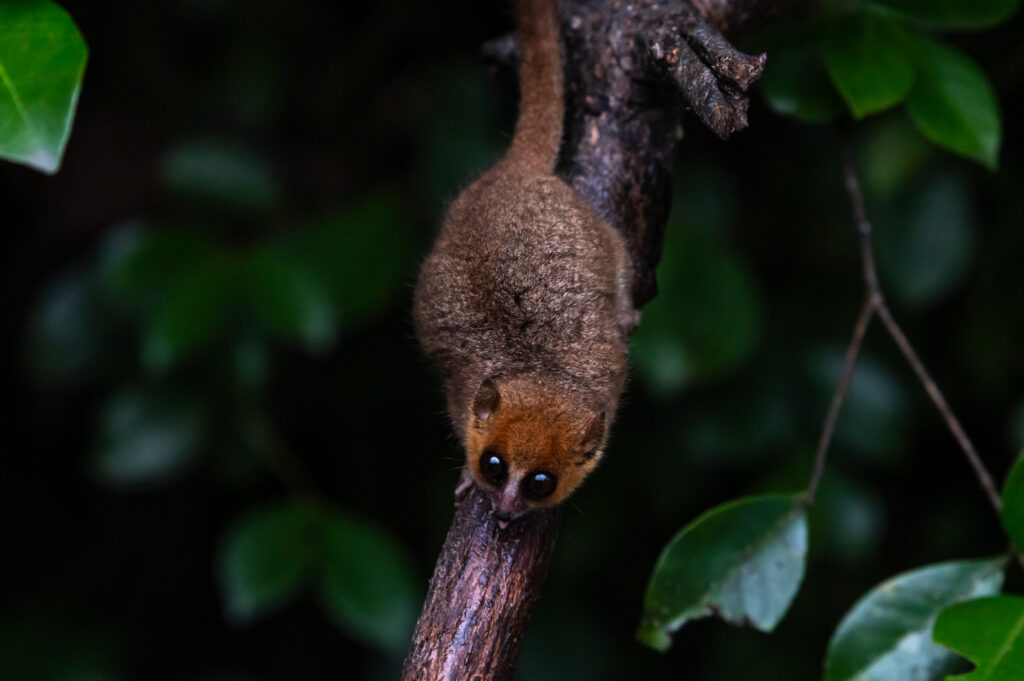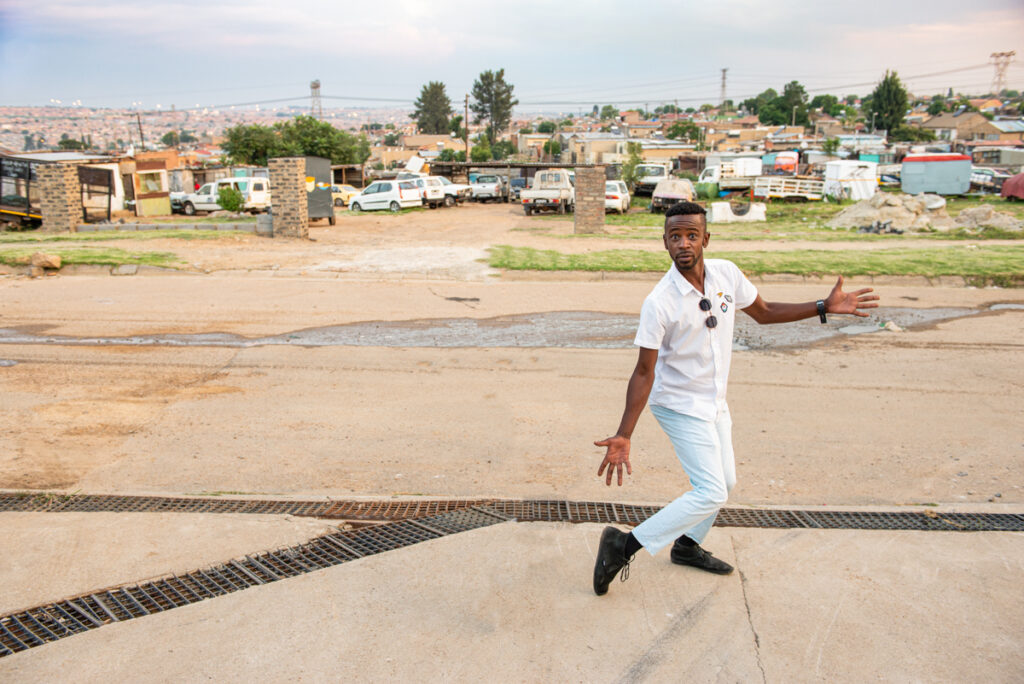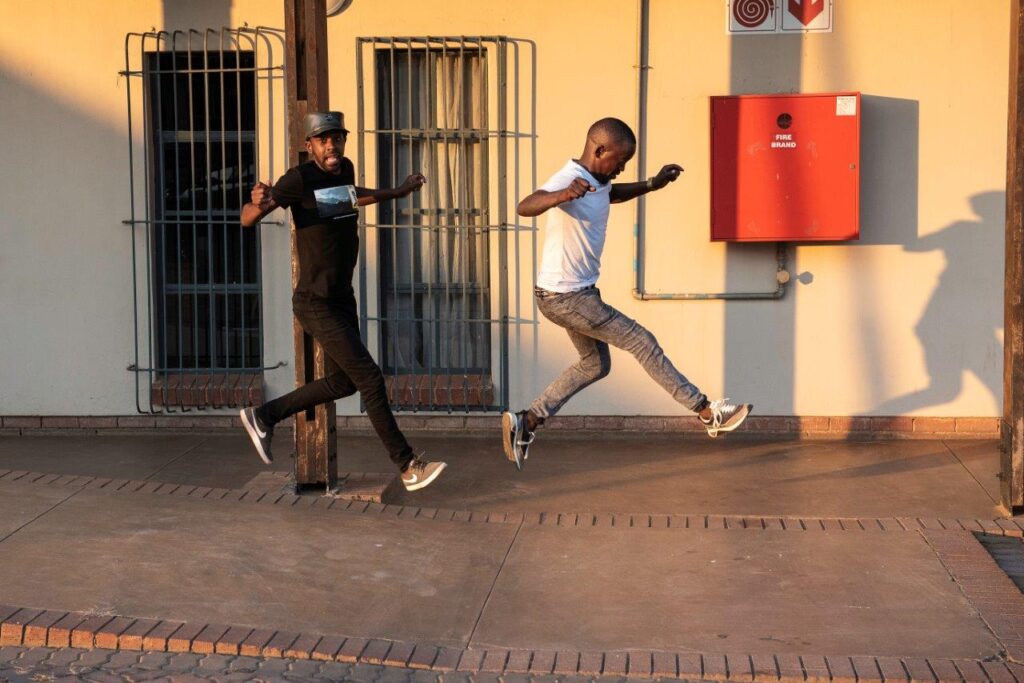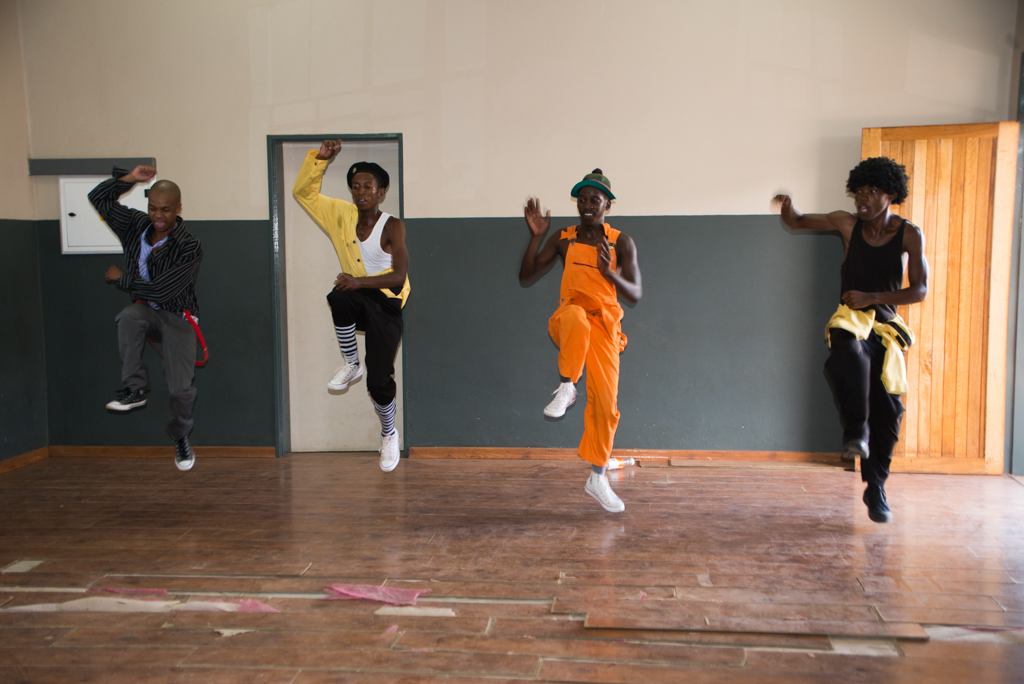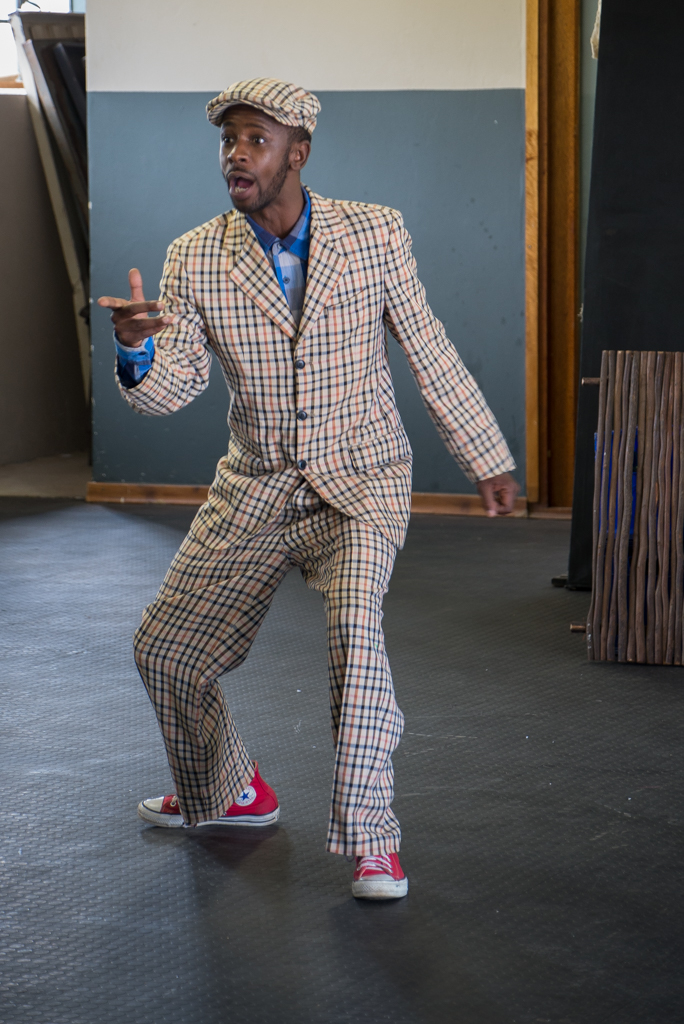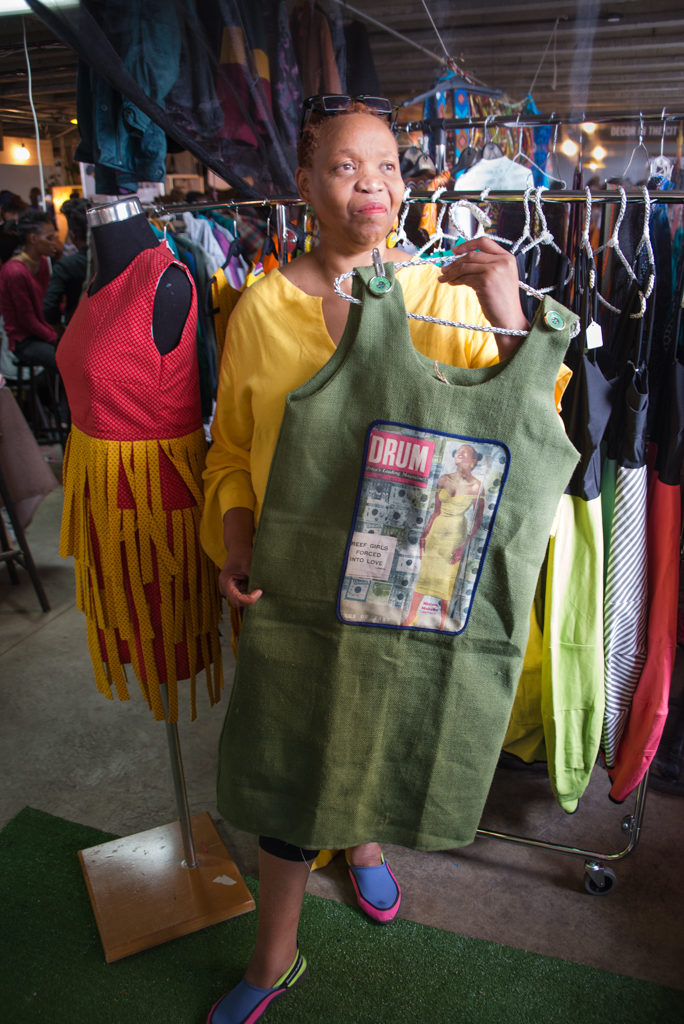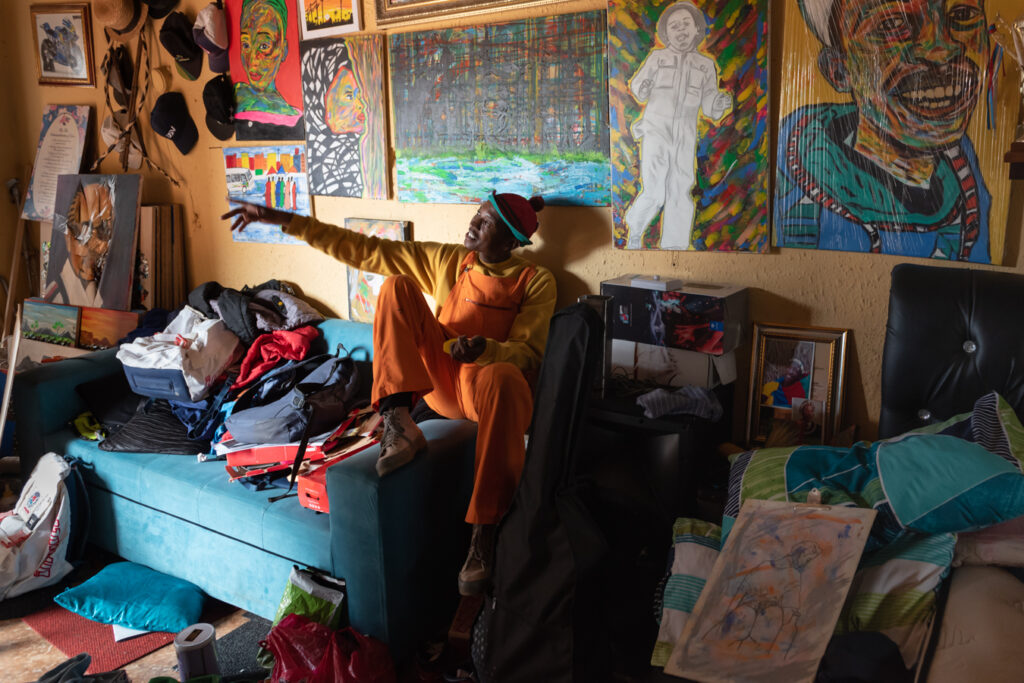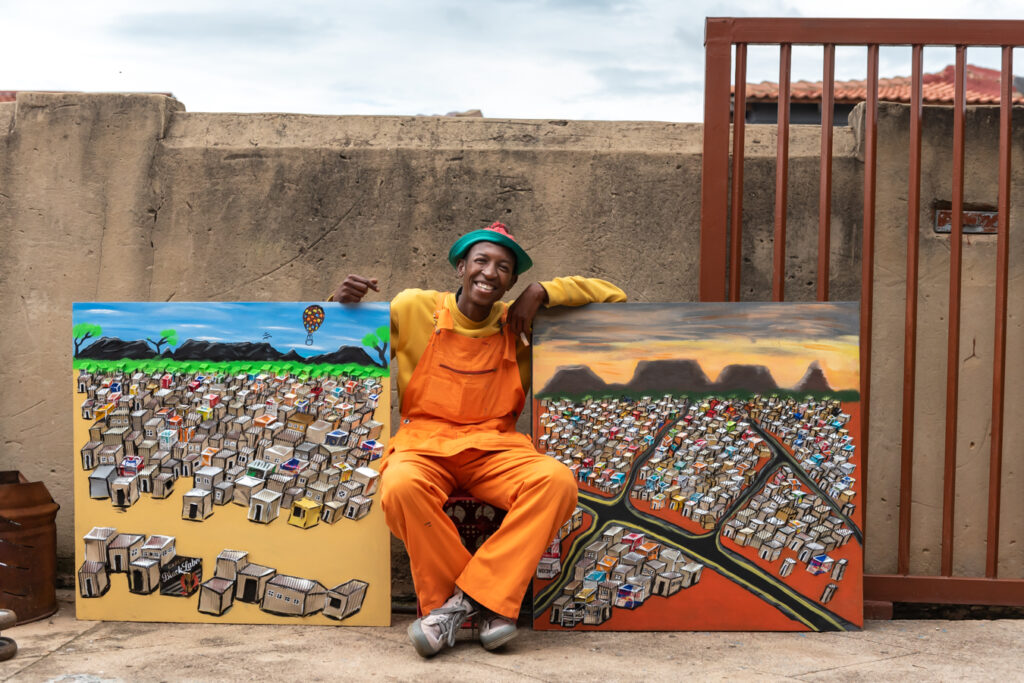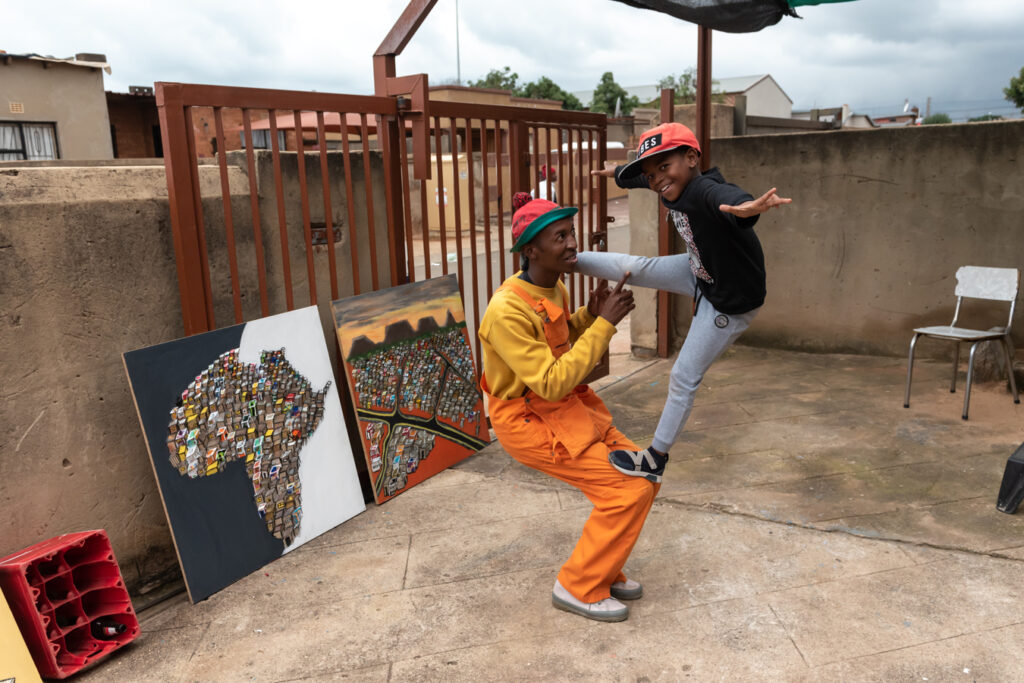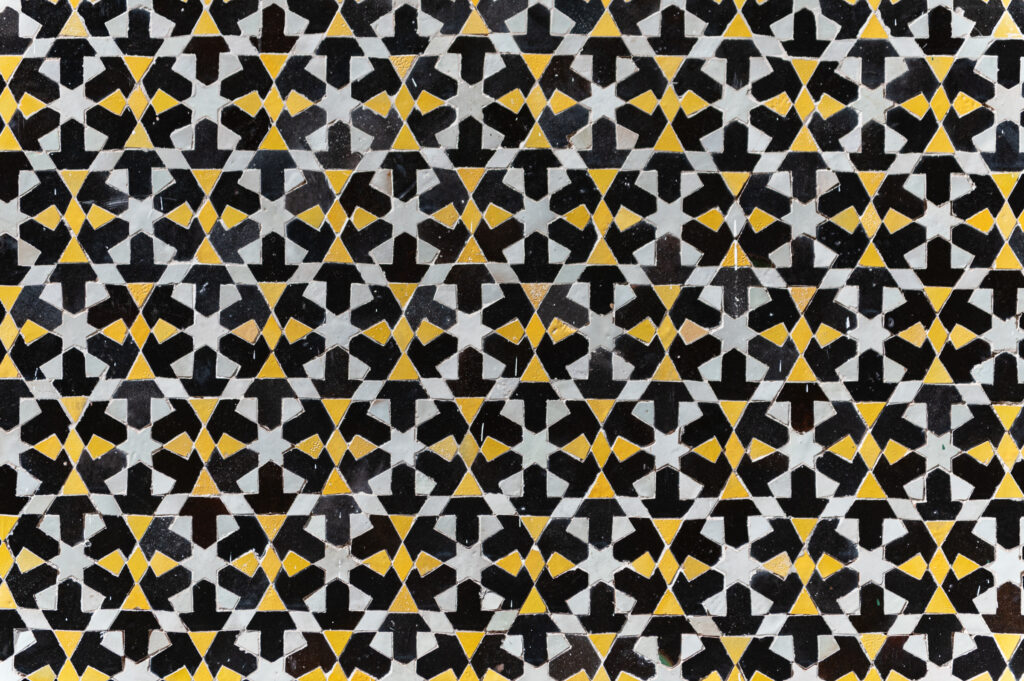
Allahu Akbar. The words stretch and turn like yarn from the spindle, glistening in the sun with the crackling from outdated amplifiers. From the rooftop terrace of Café de France on Jemaa el-Fnaa Square, one can see a group of men gathering in the dark triangle of shade behind the souk. They have taken off their shoes and kneel on colourful carpets laid out on the cobblestones. Their eyes are closed, their hands rest firmly on their thighs as they bend forward in devotion. Then another muezzin from another mosque nearby begins his adhan, his call for prayer. Allahu Akbar. Then, from another mosque somewhere in this city, another, then another, and another, and another. Allahu Akbar. Allahu Akbar. In the air thick with Saharan heat the words float; they plunge and surge like the swallows, entwine in mysterious patterns, weaving a thick fabric that envelops all.
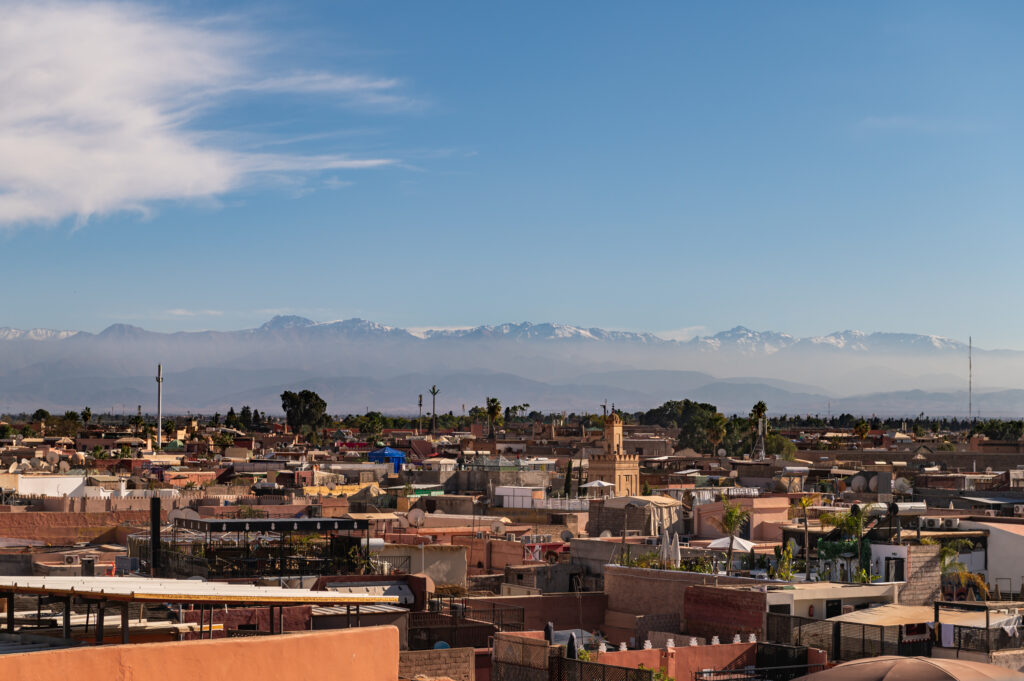
It is unusually hot this February, which could easily pass for June. But the people in the streets wear long-sleeved woollen shirts called haiks under hooded, ankle-length kaftans called djellaba or chalwar, under down jackets called Northland or Columbia. They’re dressed for the freezing nights of the desert, for the snow-capped peaks of the Atlas towering behind the city. What saves from the cold, saves from the heat, Abdel the taxi driver says. The old Moroccan adage might explain why no one died from heat stroke last summer, when on three consecutive days the mercury soared to some unprecedented 52C. As the orange fireball of the African sun melts into the palm studded skyline, it is only the tourists’ shoulders at Café de France, that shimmer salmon red like the city below.
Al-hamra, the red one, as Marrakech is dubbed, was built from red clay of the Sahara. Nomadic Berber tribes had roamed the dunes for tens of thousands of years. (Or possibly much longer: In 2017, 300,000 year-old human fossil were discovered in North Morocco, the earliest evidence of homo sapiens.) A thousand years ago, the then ruling Almoravids, the first Muslim Berber dynasty, whose empire stretched from present day Dakar far into present day Spain, drafted craftsmen from Cordoba to build a new imperial city and turn this deserted land into the Land of God: Amur n Akush, from which the name Marrakech is supposedly derived, literally means the sanctuary of God in the local Amazigh (Berber) language.
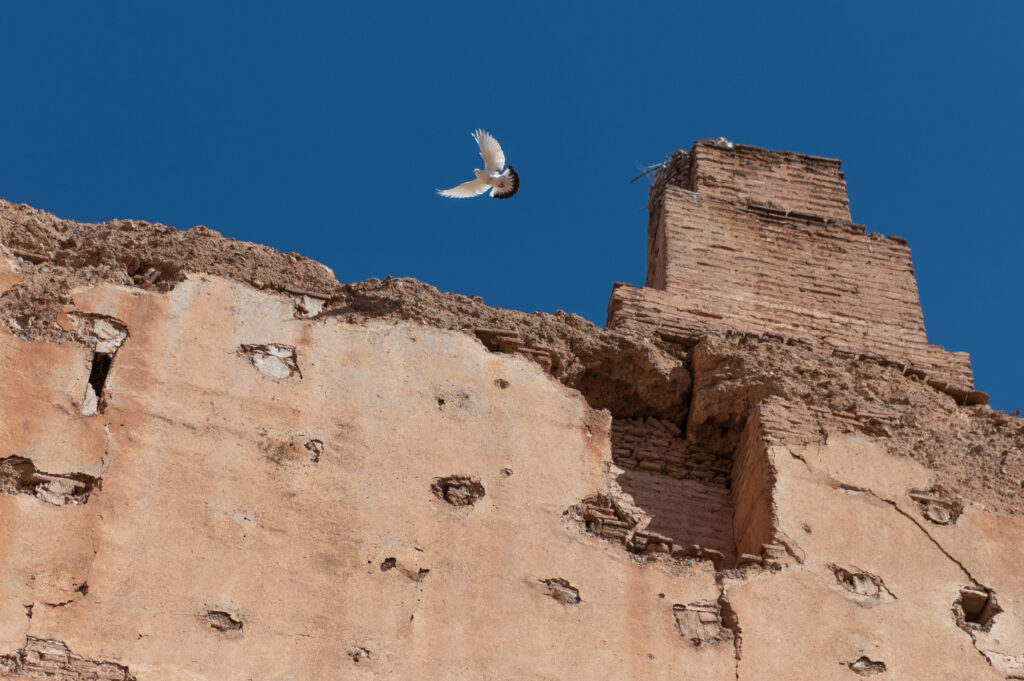
The master builders applied a construction technique. As evidence suggests, Tabia, or rammed earth, had been used on African soil since neolithic times. This method consists of mixing damp clay with sand, straw, and lime, then compress it to half its size inside a high wooden frame. The process is then repeated over and over until the frame is filled. When the wooden scaffolding is finally removed, a solid brick wall stands on its own. Upright soil, pointing skywards.
This way they built palaces, gardens, bathhouses, and mosques, and a city wall around it all, everything bearing like navels small holes in their facades. These are where once the frames’ wooden beams held up the still damp clay. Pigeons nest in these holes, but it is said that through these holes the walls breathe.
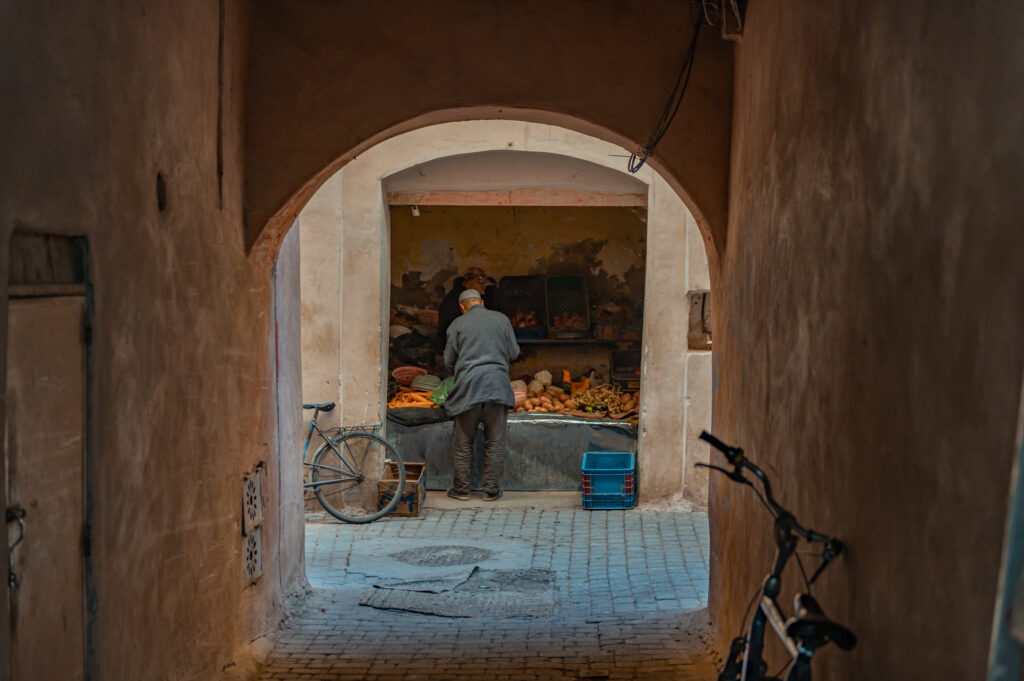
It is impossible to not get lost in Marrakech. The historic center, the medina, a UNESCO World Heritage Site, is overwhelming in its abundance of colours and sounds and scents. Sputtering mopeds fly by like jinns, leaving but a whiff of black diesel smoke. There is the demure clacking of ragged donkeys, and the rattling of their overloaded carts. At the shopfronts, polychrome ceramic pots are piled man-high. Leather-slippers in primary colours dangle from every wall as eagle-eyed vendors prey on hapless, disoriented tourists, and lure them into their cavernous shops where more carpets and pillows and copper lampshades wait. The medina is one never-ending souk – or has one been going in circles? As the lanes twist and turn, the destination is out of sight, or long forgotten. The sky is but rare blue glimpses between the sun sails, the cotton veils suspended from the roof tops; daylight is but glowing pillars of white that lift the intricate wooden trellis above. The entire city is veiled.
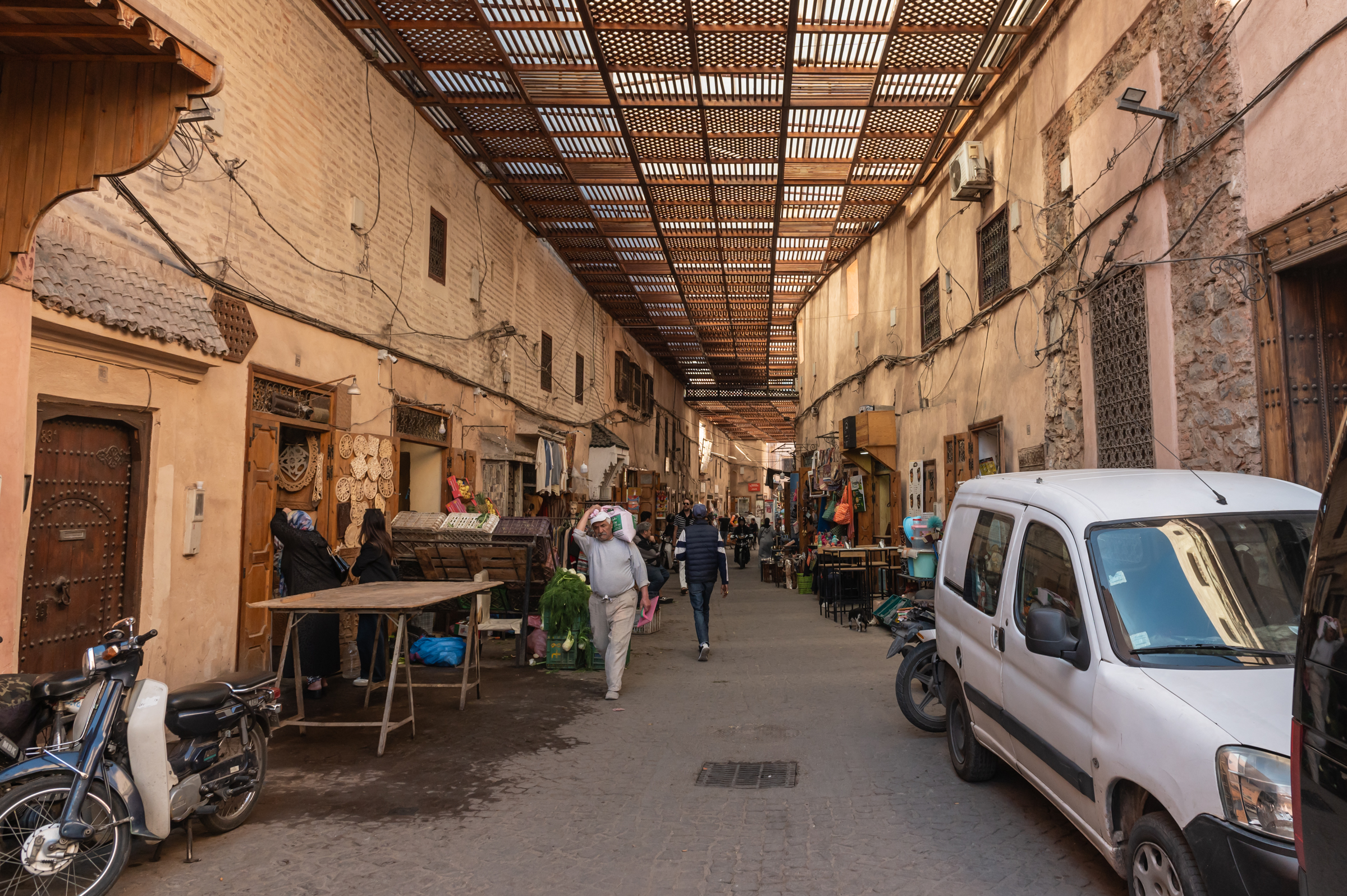
Moroccan women don’t cover their faces. Some wear a headscarf; some flaunt long black hair and golden earrings. Moroccan Islam is traditionally moderate. (In 2017, ahead of any European country, the Moroccan government ruled out the production and import of burqas.) In the tradition of the Imazighen, the Berbers, only men cover their faces with a tagelmust or litham. The long piece of indigo-dyed cotton is wrapped around the head, its loose end covering mouth and nose to protect from the sandy Saharan winds. This fashion stems from prehistoric times, as desert rock engravings depicting human faces without mouth or nose suggest. But within the city walls, there is no need for protection. The city itself is a turban, a veil, a head wrap: the lanes spiral endlessly, narrow into dead-ends, disappear into underpasses that lead to another souk, another house, another souk. Marrakech is a cacophonous cocoon that keeps warm and cool, and safe.
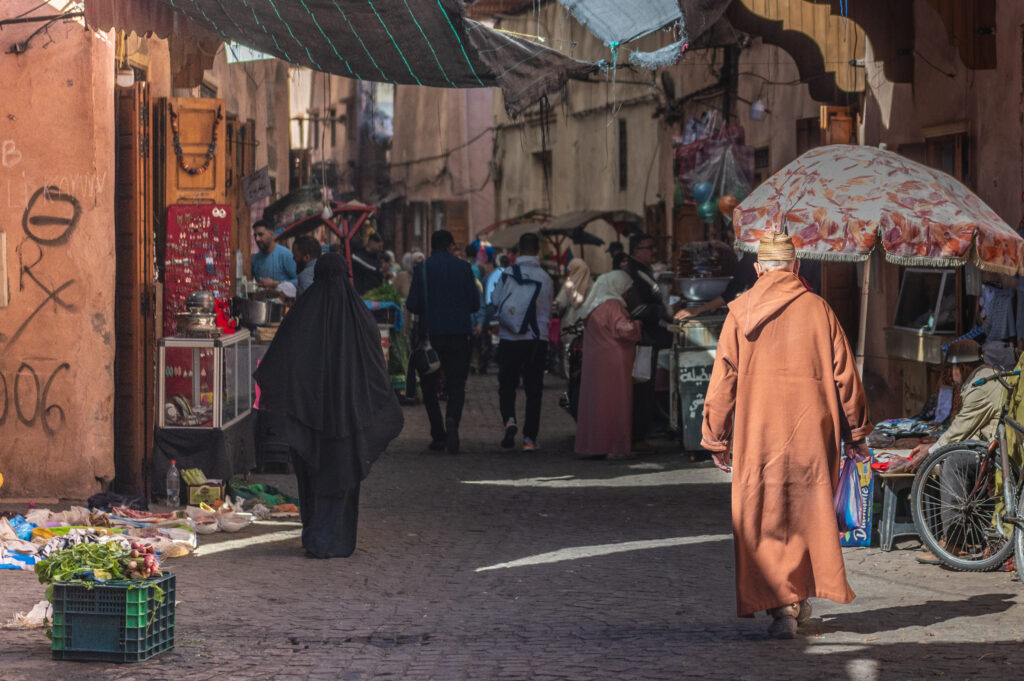
Within the chaos and confusion, there is silence. It can be found at every corner: a zawiya, Arabic for corner, is a sufi prayer room or monastery. Silence waits in the myriad mosques and madrassas, the quranic schools, secret hideouts in the back lanes, given away only by a heap of shoes at their doorsteps. Peace and calm drift from these doors like heavenly scents.
Contrary to the mosques and zawiyas, Madrassa Ben Youssef from the 14th century, is open to visitors. The square building with its courtyard is captivating not only in its serenity, but in its disorienting melange of patterns, patterns, patterns. The tiled floors are kaleidoscopic arrangements of contrasting triangles and shingling loops, of greens and blues and yellows, of brilliant whites and sparkling golds. Sunlight filters through wood-laced windows, staircases lead up and down, a cool breeze spirals like the water that flows upwards from ancient cisterns. Lost in the multitude of shapes and shades, one wanders. It is a pleasant feeling to be lost. To be lost is a solace.
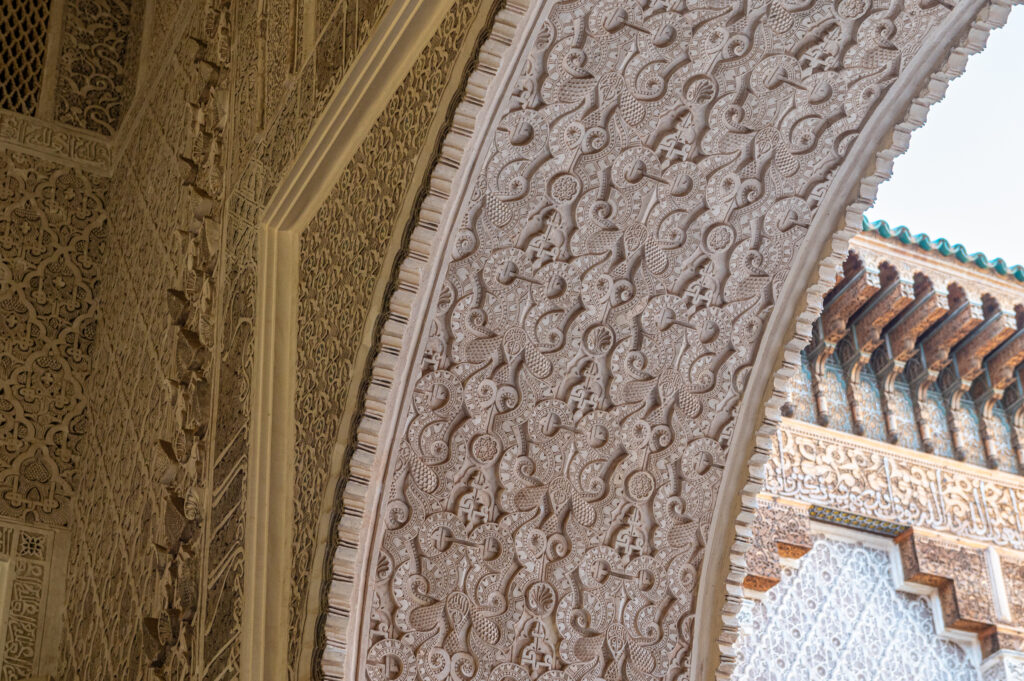
The Medina is scarred. There are cracks running through the old buildings. Shockwaves of the catastrophic earthquake of September 2023 in the nearby Atlas mountains caused many of the old buildings to collapse. Now, after 1,000 years, scaffoldings are back up in the Medina. They secure the buildings barely left standing. The locals walk by with equanimity. They tell of this or that neighbour that was buried in the rubble. Are they scared of another earthquake? They shrug their shoulders. It’s God’s will, they say. Inshallah.
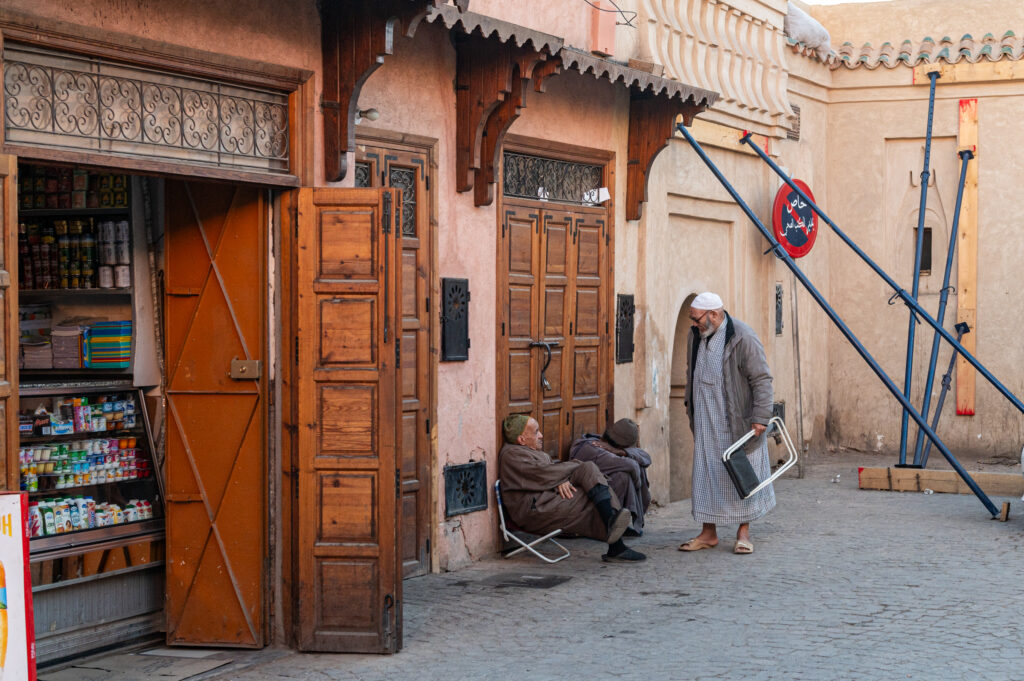
The birds are always singing in the Medina. Goldfinches and weavers, chaffinches, and buntings whistle and warble from the walls, from shop doors, from upper floor windows one hadn’t noticed until then. The tiny birds are kept in little cages furbished with mirrors and fresh fruit and water fountains. Their owners look after them with great care, they shower them, feed them, keep them warm in the night and cool in the day. It’s because these birds weren’t born in the wild, they say, that it is up to them to provide for them. Safeguard them from the stray cats that are out on the streets in the thousands. Do the birds sing in gratitude? Or do they sing to remember and honour their ancestors, those who flew freely?
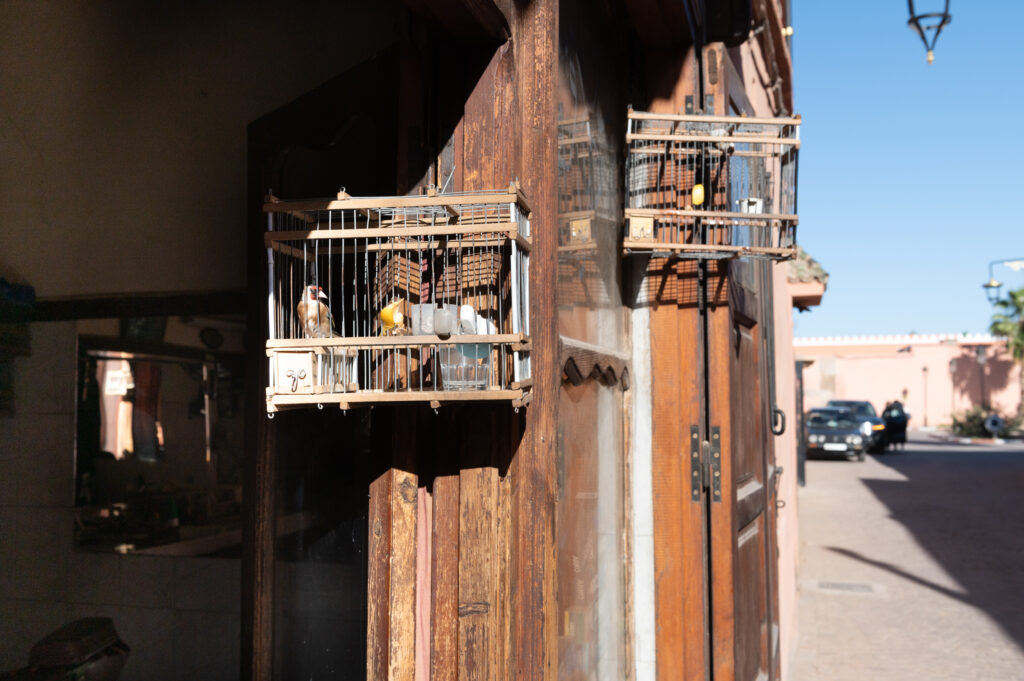
In the black of the night, Jemaa el-fnaa Square vibrates with rhythm. There are drums. There are wailing songs and croaky call-and-response chorus. There is the ragged, cyclic galloping of the qraqebs – heavy, double-headed, cymbal-type instruments. And there is the all-commanding reverberating bass of the guimbri, the three-stringed African lute. Its player sits cross-legged on a threadbare carpet and slaps the strings with his thumb while his curled fingers knock against the camel-skin-face of the wooden corpus.
“I determined to go and live where I could be surrounded by sounds like those, because there seemed to be very little else one could ask for in life,” Paul Bowles wrote in the 1950s.

The musicians are Gnawa. The term, which refers to the music and its players as an ethnic group, means ignorant or black in the Amazigh language. The Gnawa are the descendants of sub-Saharan African slaves who for centuries were walked through the desert to be traded in Marrakech, not far from Jemaa al Fna, on Rhaba Khedima square where today only spices and carpets are sold. The slaves brought with them their African music styles: The polyrhythms, the call-and-response chanting, the dances: music to heal the wounds of exile. Music to remember; to honour their ancestors.
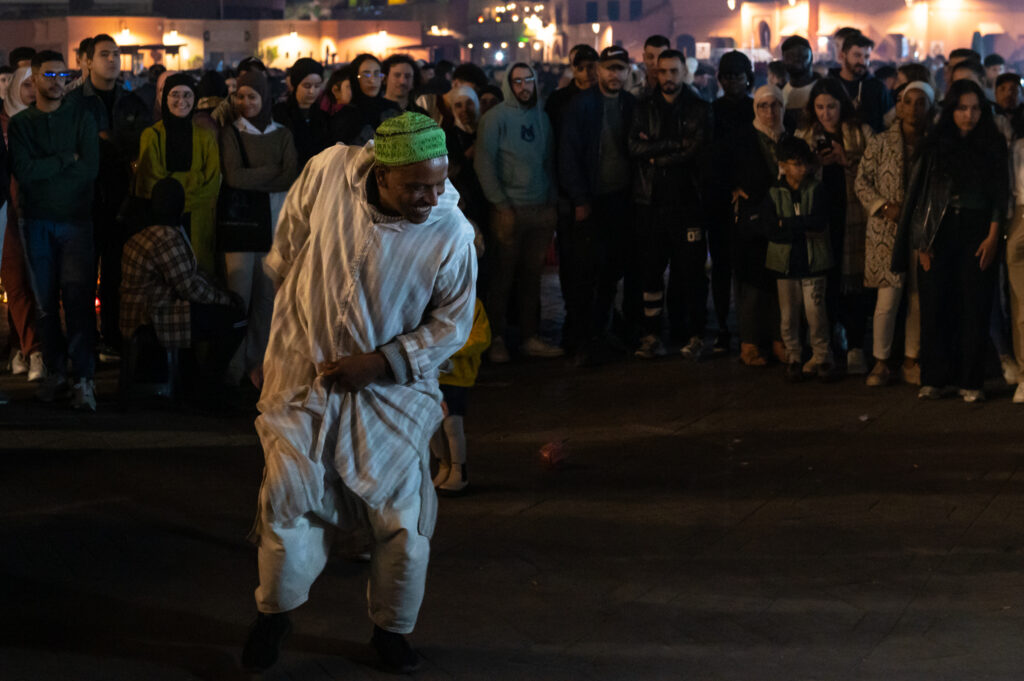
Uprooted and orphaned, the slaves didn’t find solace in their music alone, but also in Sufism. The mystic branch of Islam had arrived from the east around the same time. Contrasting with the stark, then Andalusian Islam, it established itself as a counter reformist Islam. Its soothing message of love and transformation appealed to the poor, and was easily married to traditional African belief systems. Half prayer, half folksong, a new Moroccan music was born, mirroring the winding lanes, the intertwining patterns, telling of a life in search of freedom and home, like the songs of caged birds.
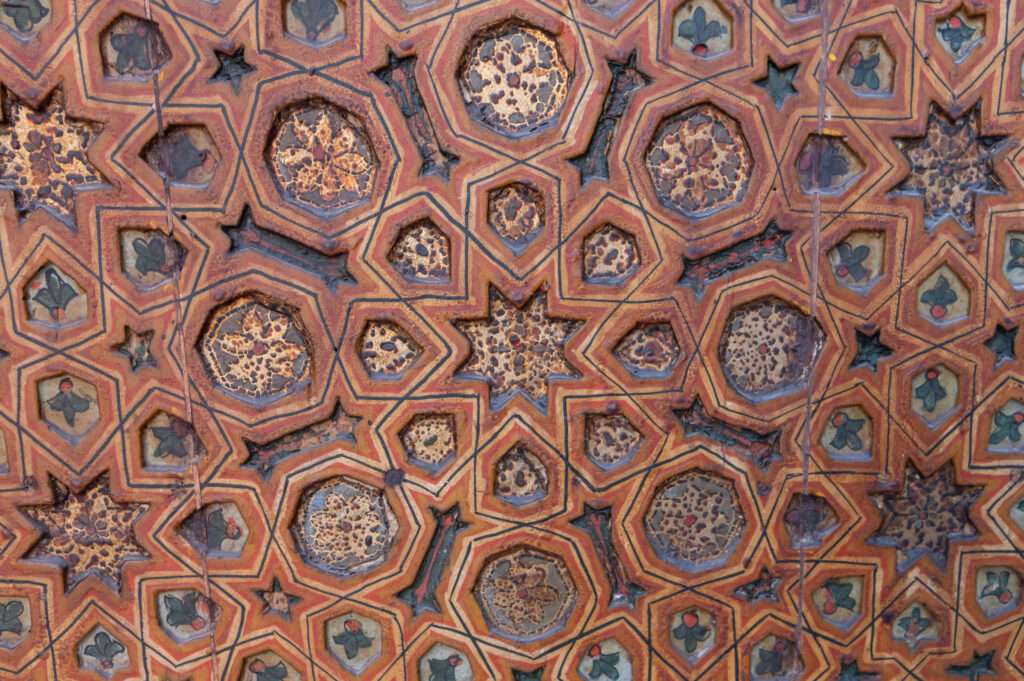
Traditionally, Gnawa rituals are held in the secrecy of private homes, religious ceremonies, to enforce social bonds and mental healings. It is only since Western musicians had fallen for its charms, that Gnawa is performed on stage, and – stripped of its spiritual and social importance. Paul Bowles, who had set out to record and preserve strictly authentic Moroccan music, had with his recordings Music of Morocco of 1959 kindled its full commercialization: American musicians from Jimmy Hendrix to Frank Zappa, from Pharao Sanders to Ornette Coleman, from Paul Simon to Madonna have since integrated Gnawa in their music. Gnawa, the mysterious Blues of the Sahara.
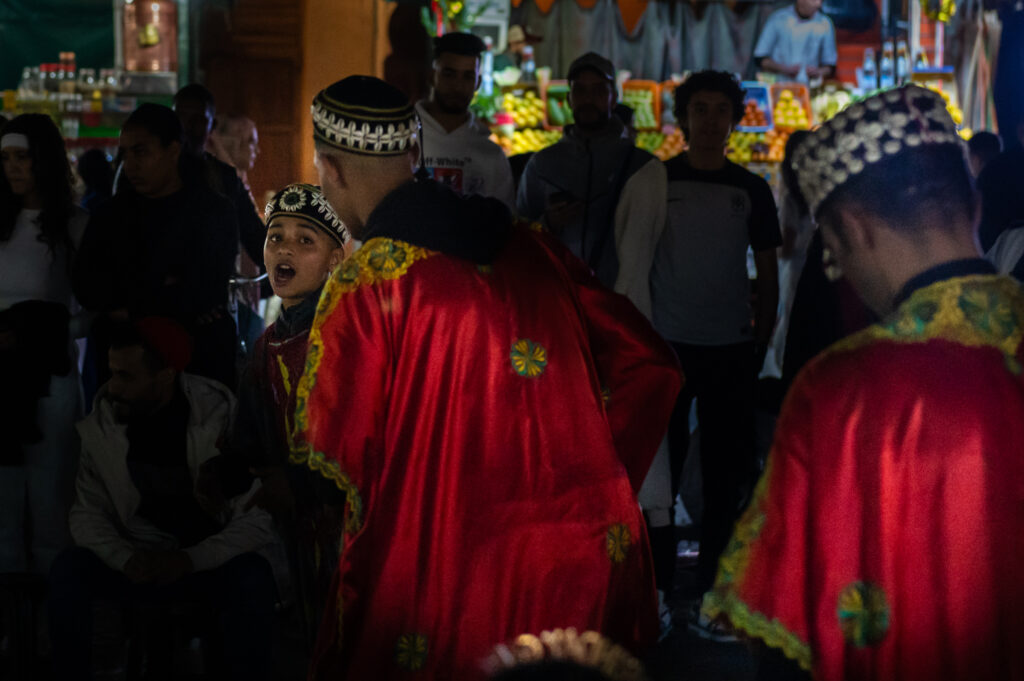
A circle of onlookers has formed around the musicians. In the middle, young men in bright coloured robes are dancing, twirling, whirling their heads on their necks, slowly entering a state of trance. Or appearing to. For all of a sudden, they stop, take off their hats and approach the sunburnt tourists in the crowd. The coins clink as they tumble and whirl in the crocheted cotton hats, an intricate counterpoint that could be taken for noise.
It is safe to say, that the Qraqebs on Jemaa el-Fna don’t evoke any animal sprites or Sufi saints, but the marketable image of the mysterious Orient, the dances spark showers of gold. Dollaruh Akhba.
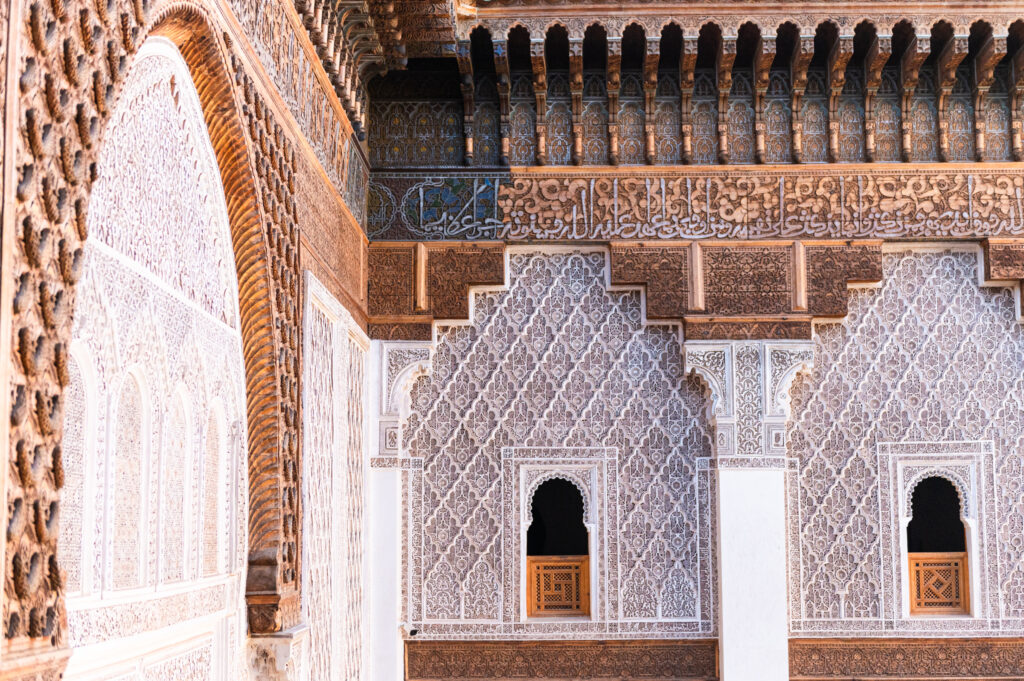
Marrakech is Africa’s most visited city and tourism its major economic driver, especially in the aftermath of a major tragedy like the 2023 earthquake. But tourism in Africa can never be separated from the continent’s colonial past: since the days of French colonialisation (1923-56), Marrakech (and its Medina) have served as a screen for Western projection of exotism and orientalism, a role with troublesome ethical implications: the romantic poverty of the back lanes, the thrill of tragedy, the moral inferiority of deprivation and misery. ‘No one escapes Orientalism’, Edward Said, who coined the term, wrote. Not Nobel laureate Elias Canetti, nor George Orwell who, while criticising colonialization, described in their famed travel accounts of Marrakech a city of poverty, chaos, and conflict, peopled by mysterious, dark-skinned donkey-drivers. A Haunting, undecipherable place; not God’s land, but a city in distress.
It is not without irony the notorious pushiness of the vendors in the souks, the notorious henna tattooists and snake charmers of Jemaa el-Fnaa, that shatters all illusion. With a merciless determination — undoubtedly owed to a bitter cocktail of poverty and questionable entrepreneurial cunning — they act their part in a play all tacitly agreed to play: but this is not the play of an entrancing, adventurous journey into the mysterious Orient. It’s that of capitalism, and the tourists’ role is to keep the money rolling, and the show running.
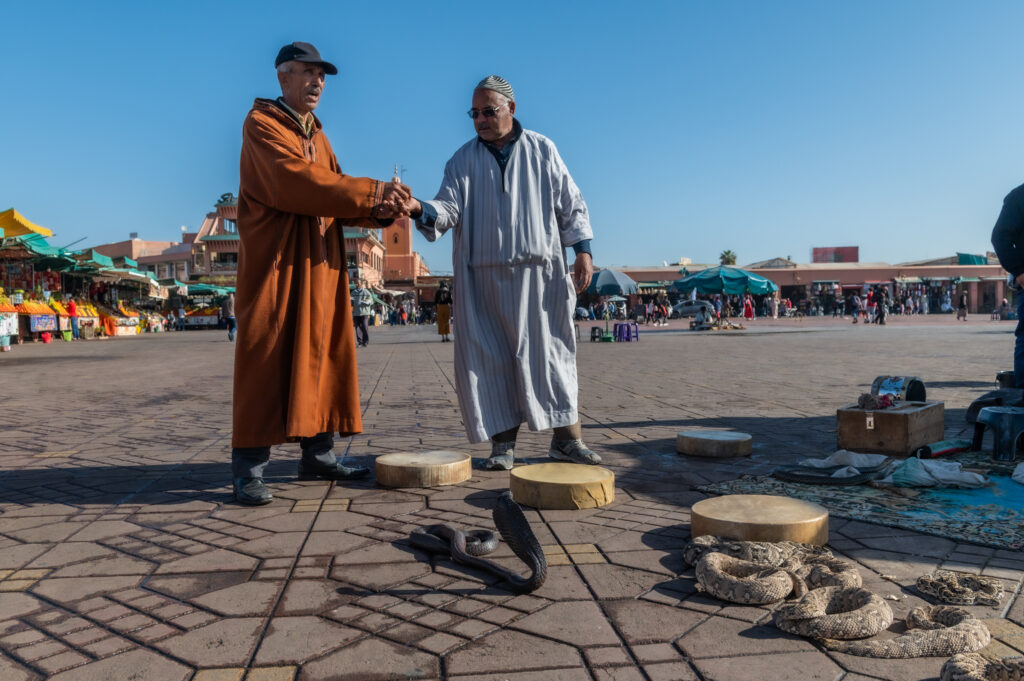
Marrakech has always been a marketplace and will always be: then of camels and slaves, now of tourists and babouche slippers. Maybe the real Marrakech is the enthralling ornaments, the very action of getting lost in the mazes of streets, in the kaleidoscope of songs and colours and the smell of cumin and peppermint: A reminder that one is never centre of the world, the measure of all things, but a tiny piece in a giant, colourful mosaic. That life is one sparkling maze in which one is lost, until one dies. Marrakech is multitude; a city to help us transform from a unitary character to one that includes the other; or to quote Edward Said: A meeting of counterpointing lines that make for a great composition.
